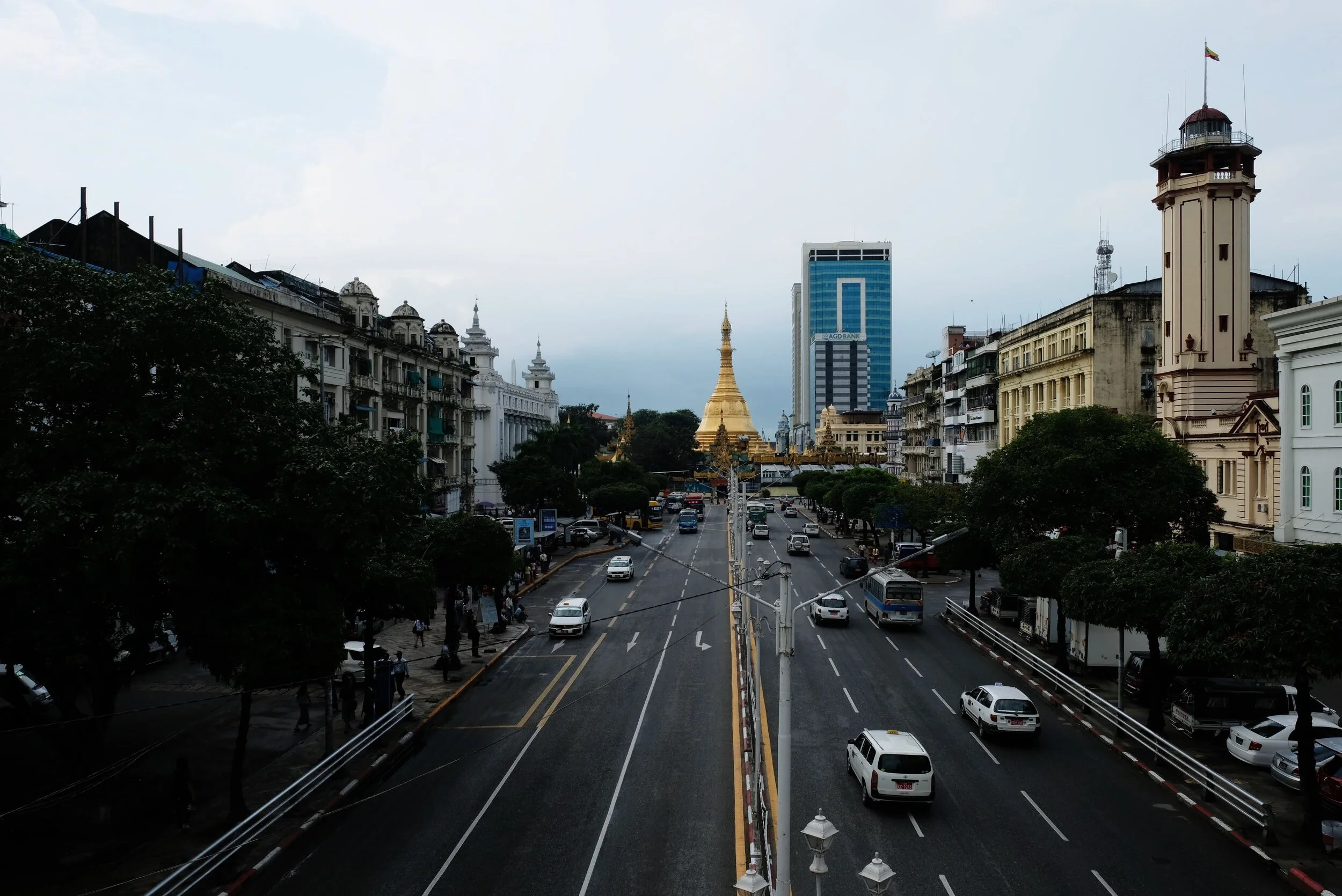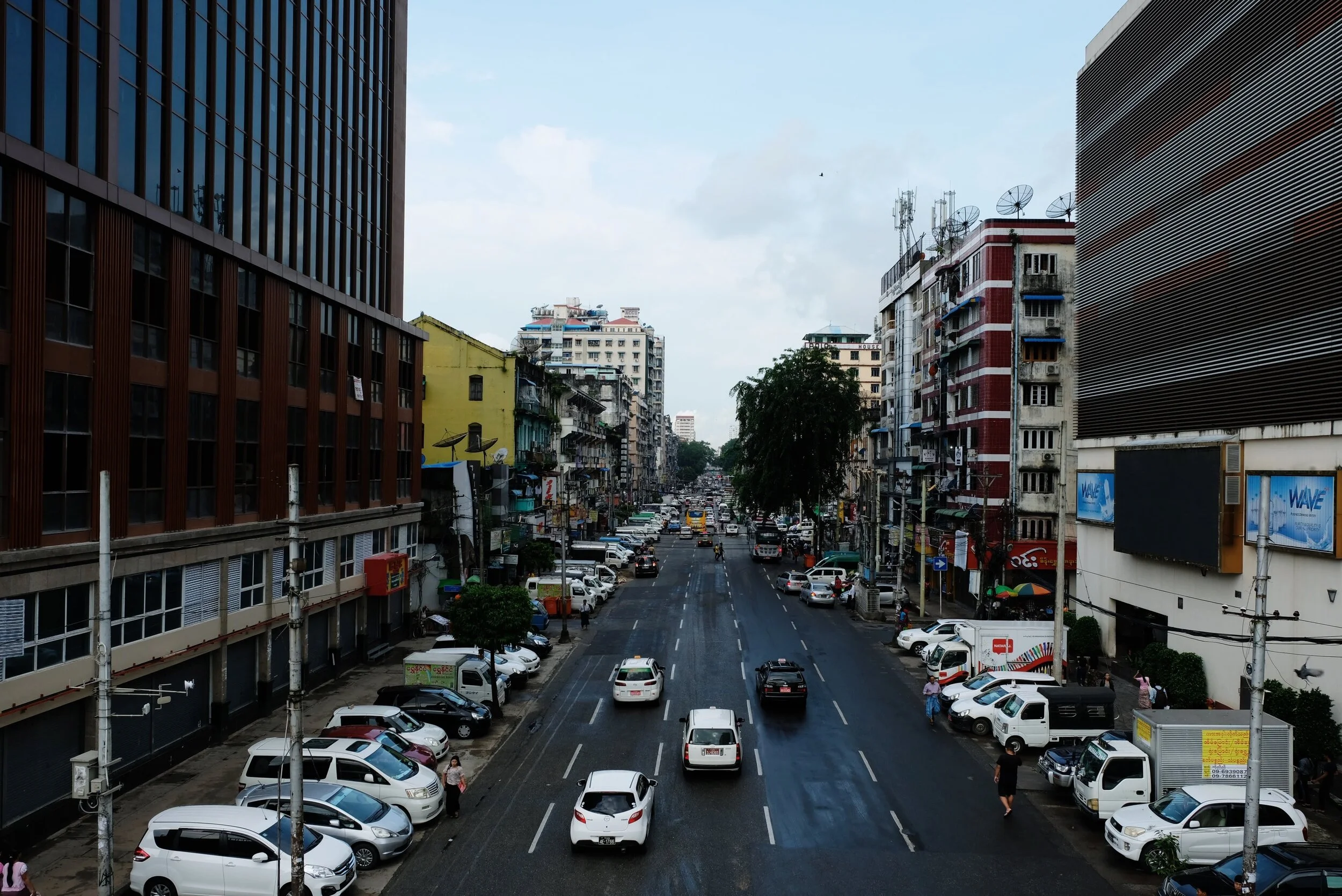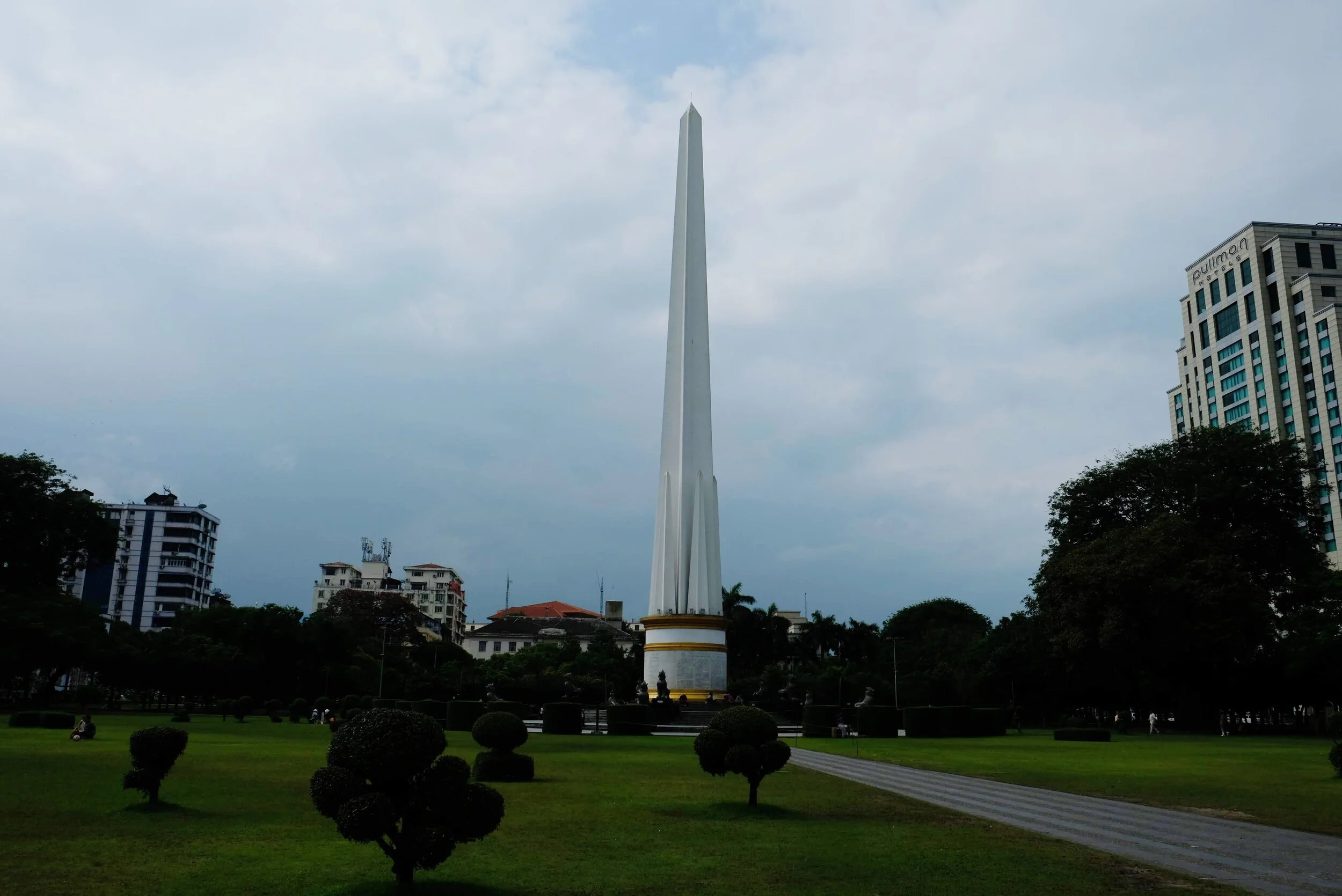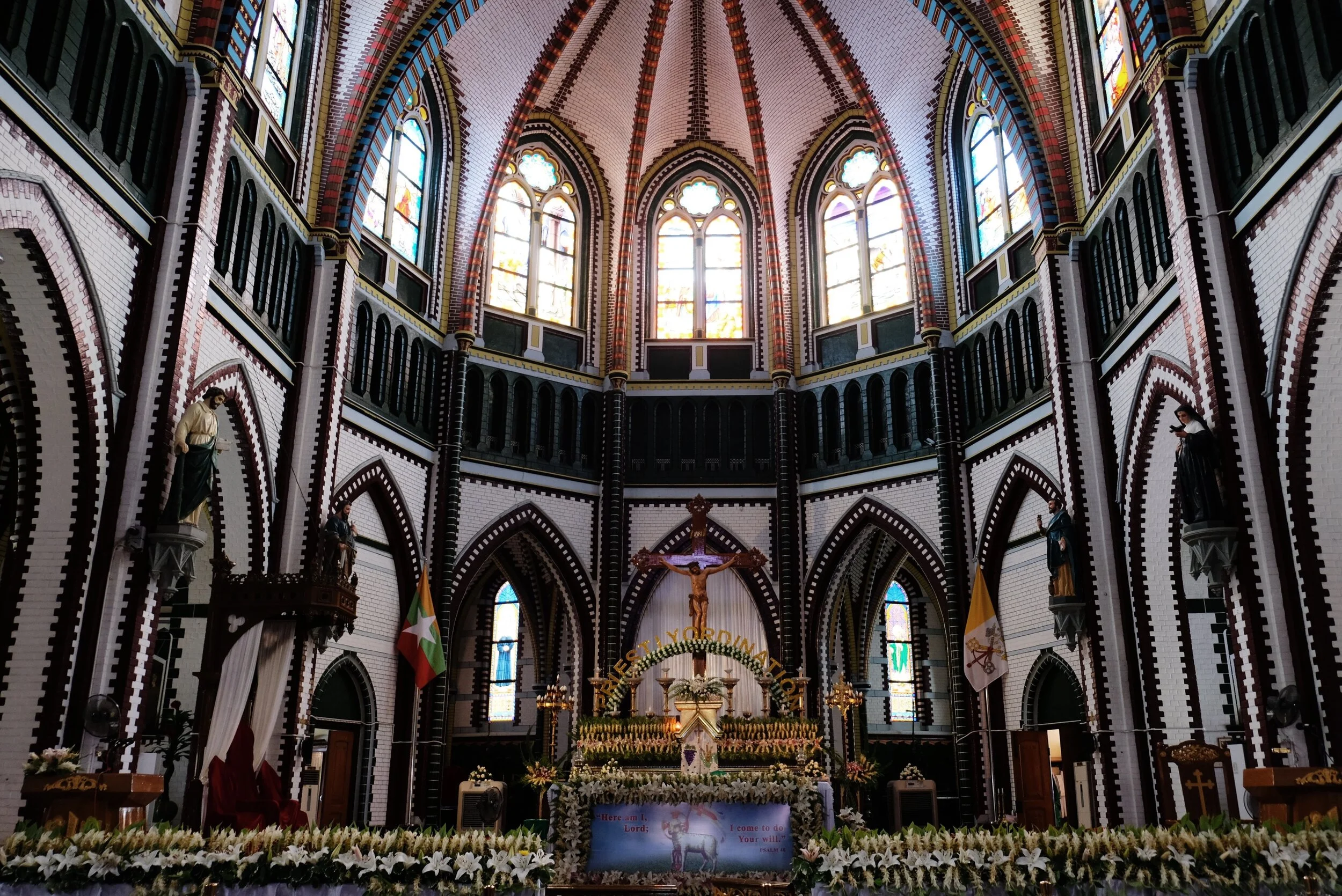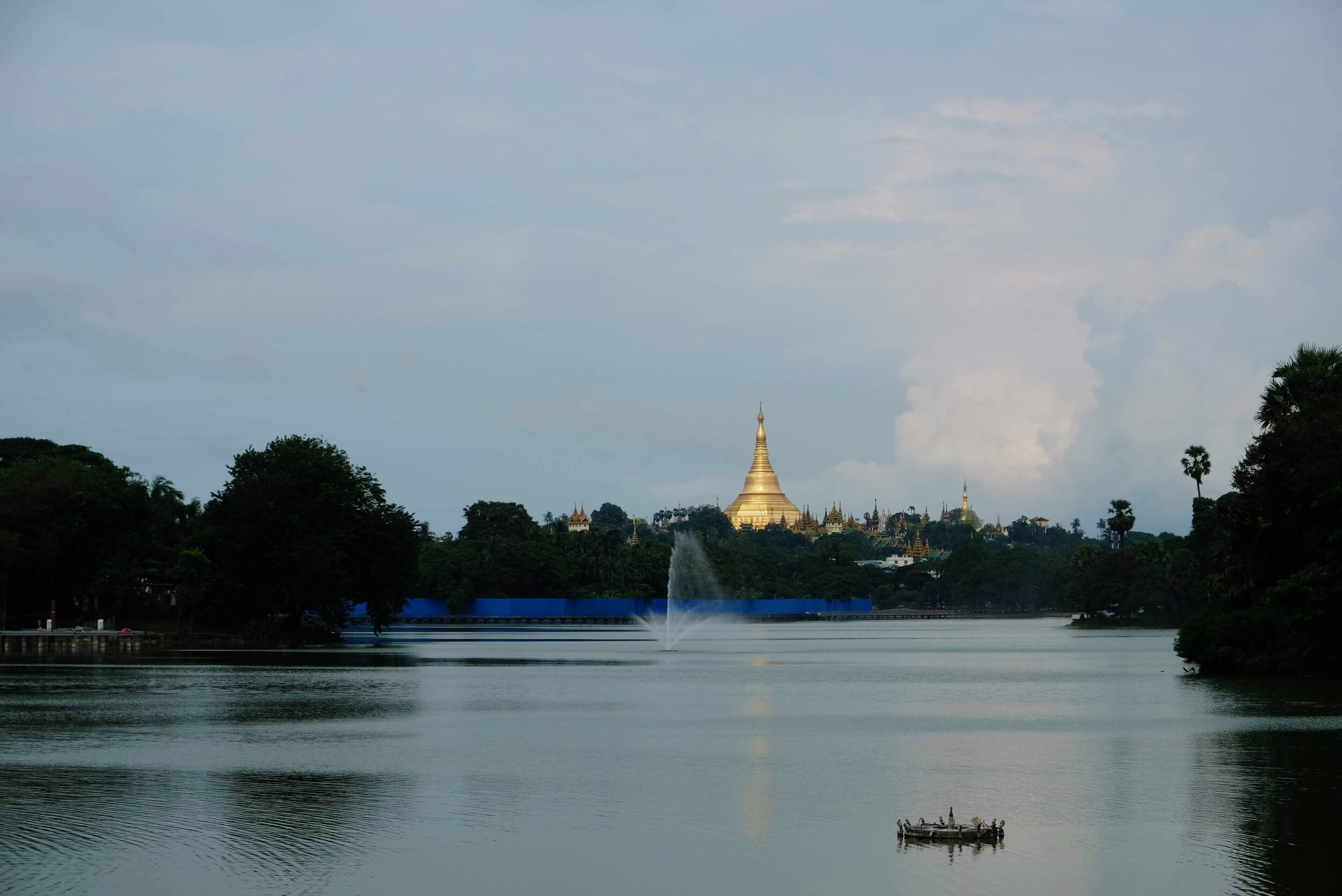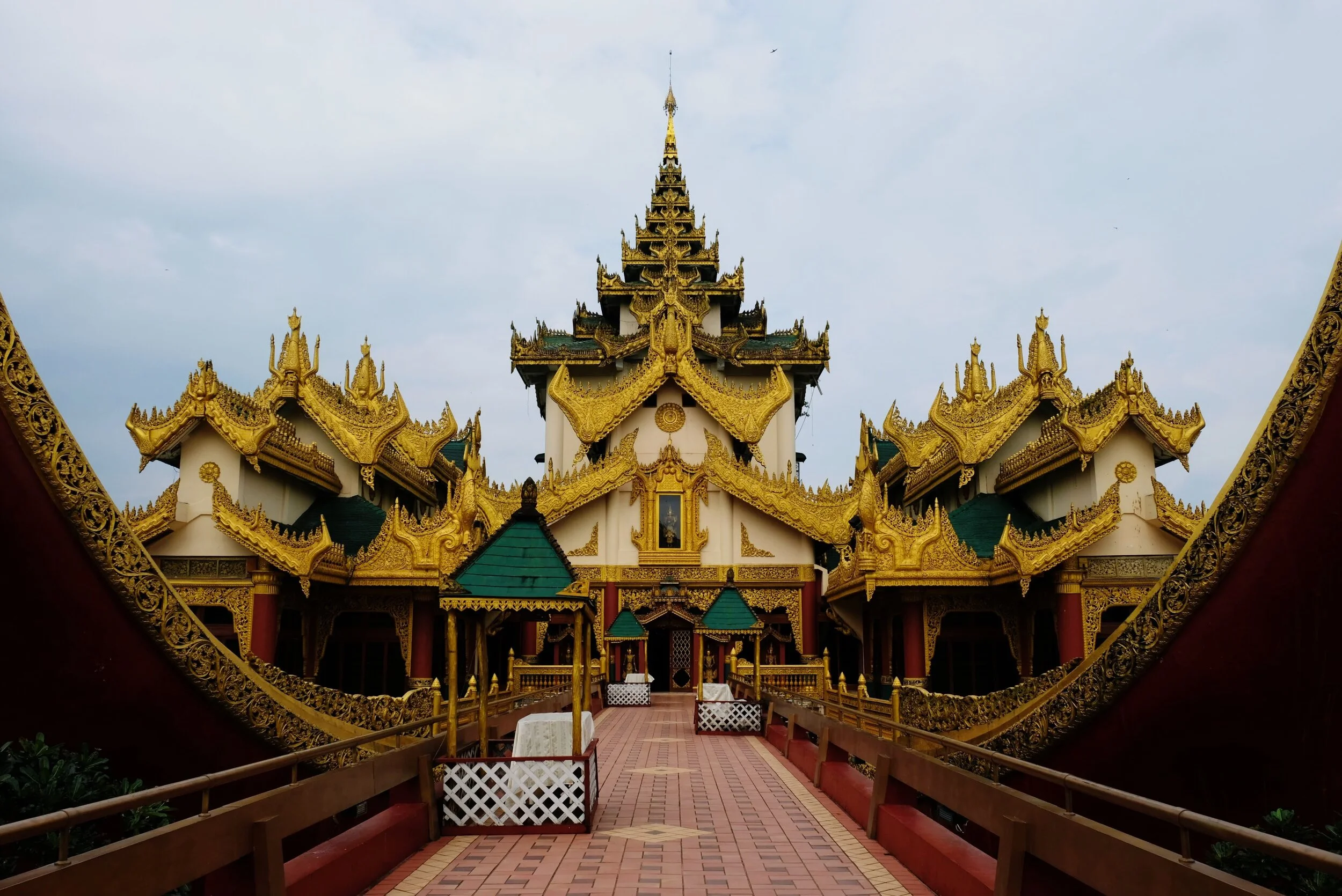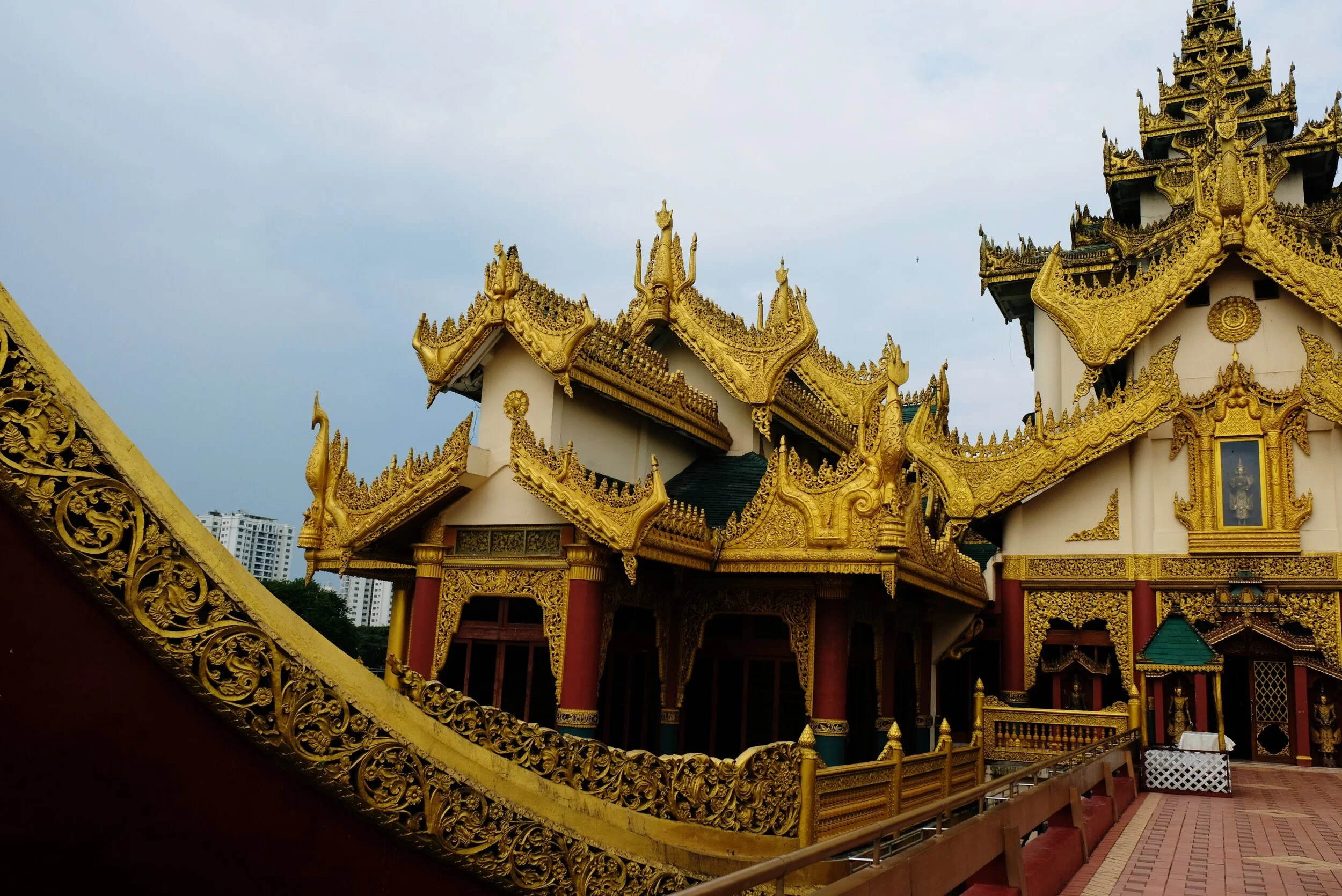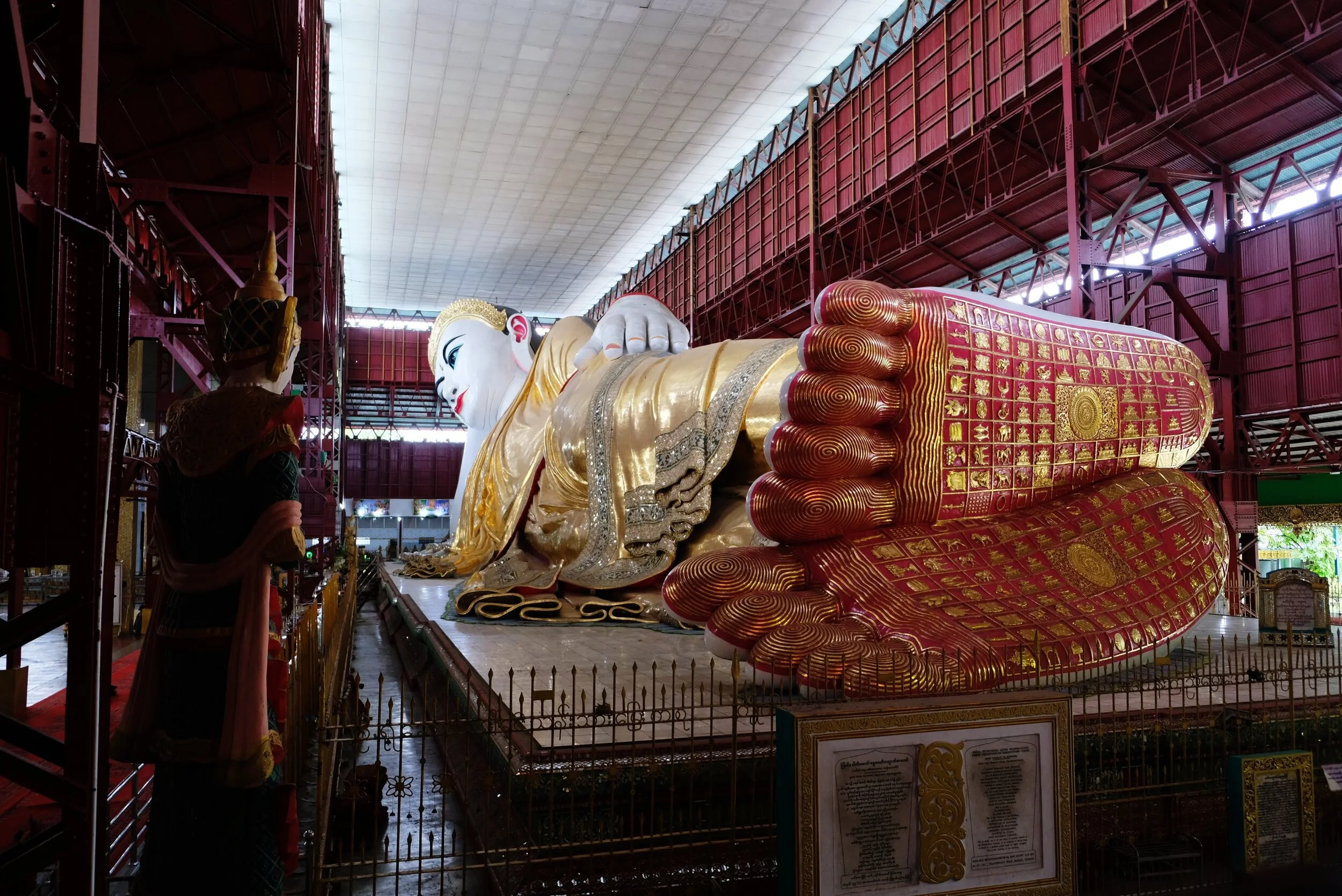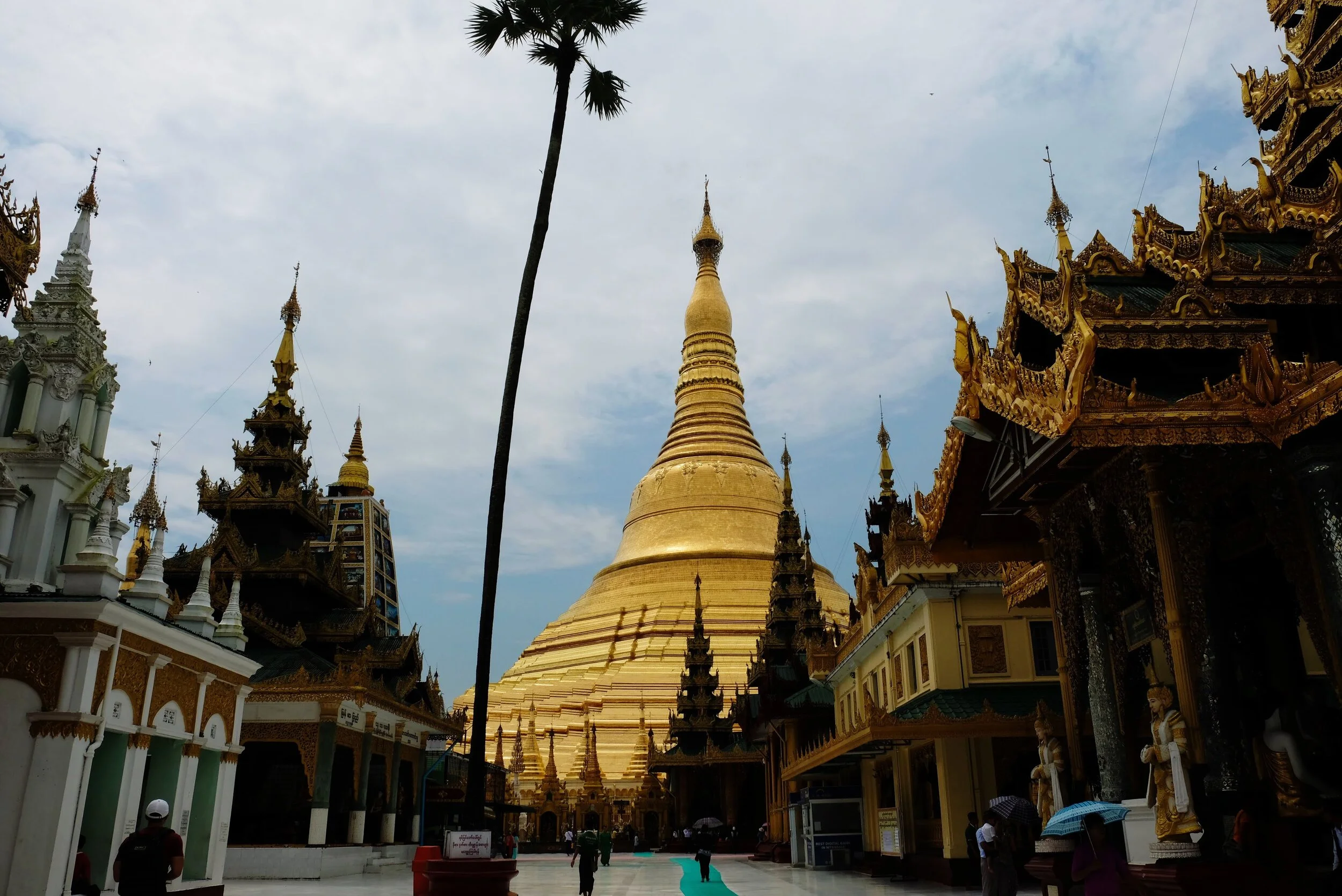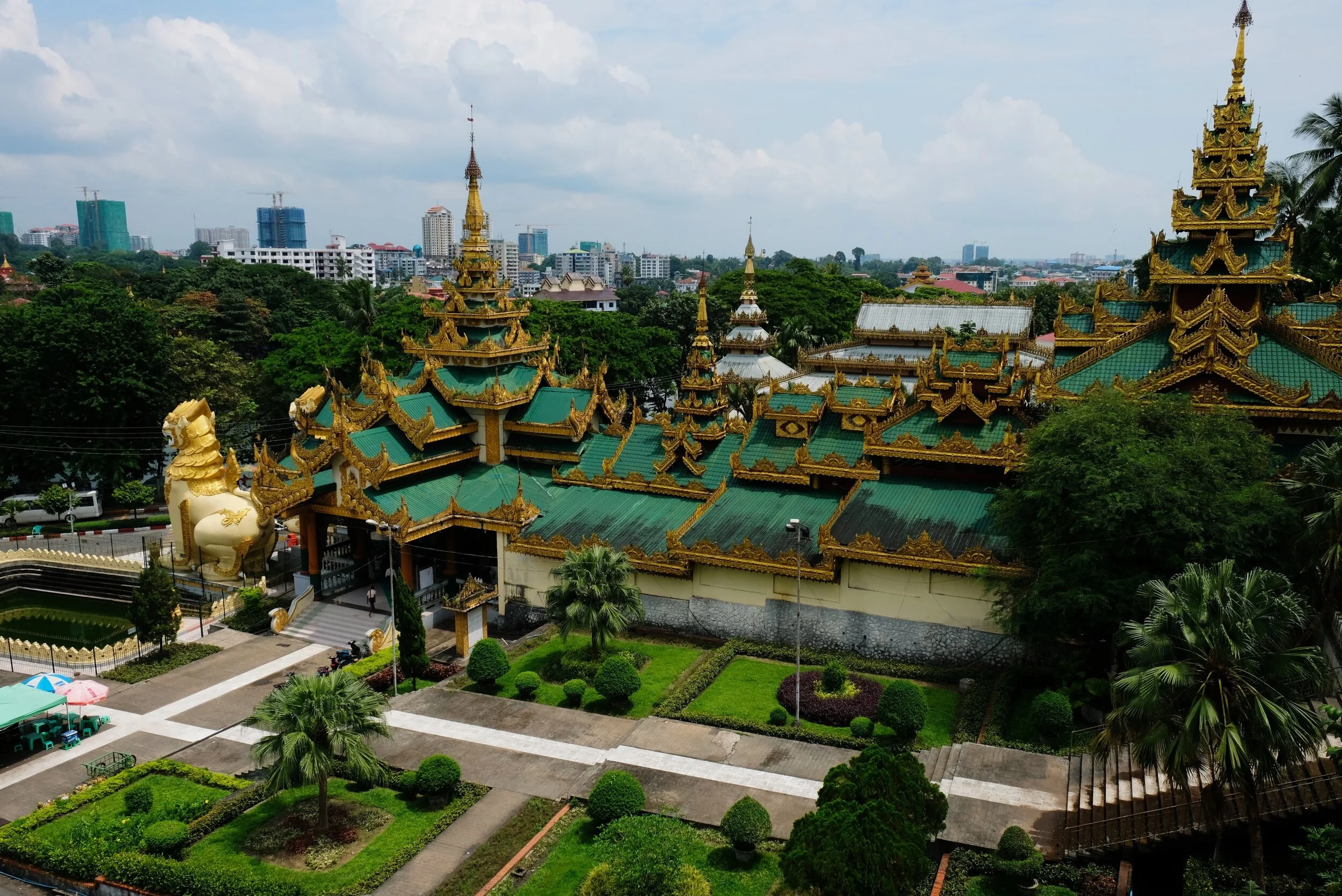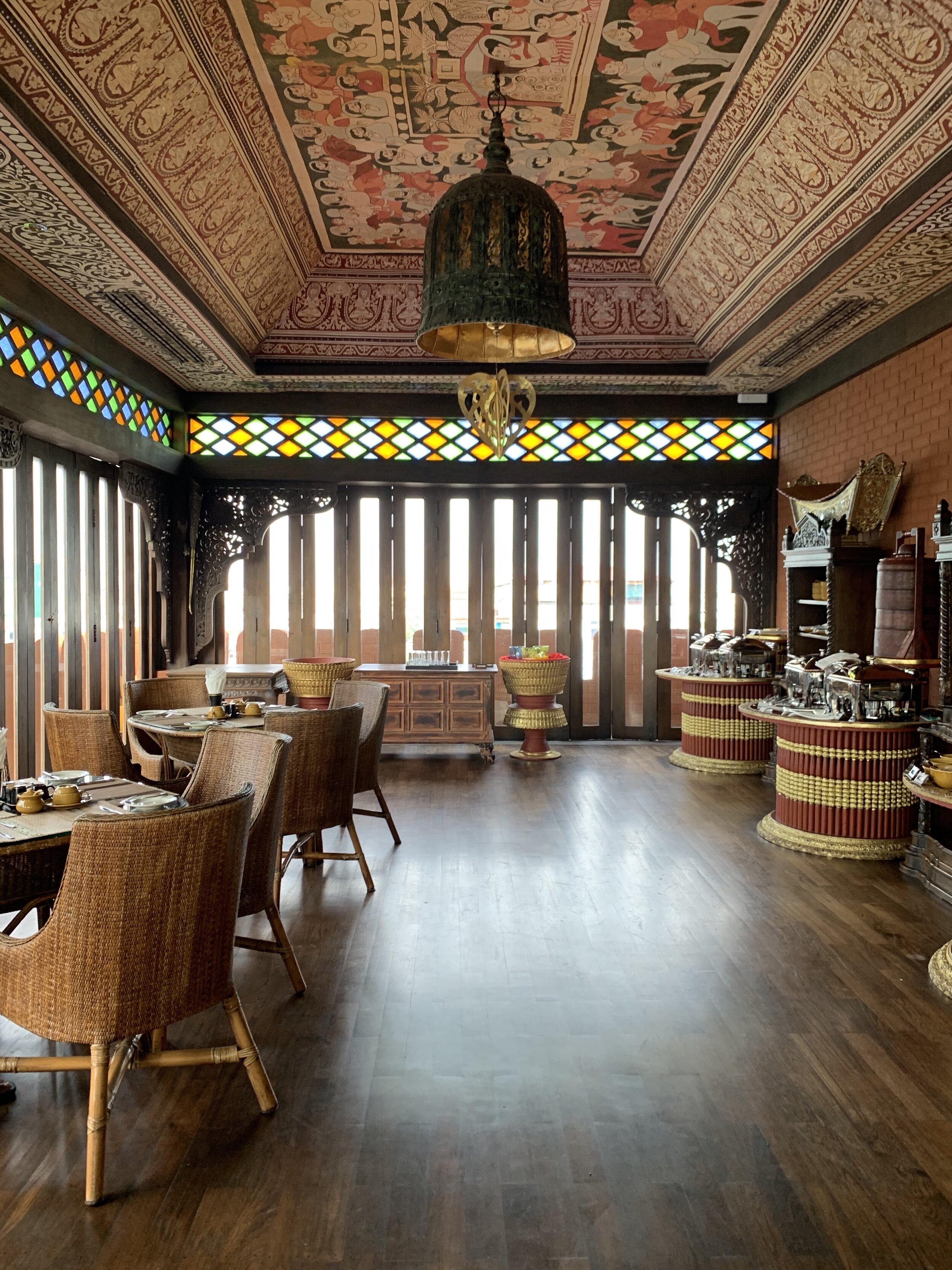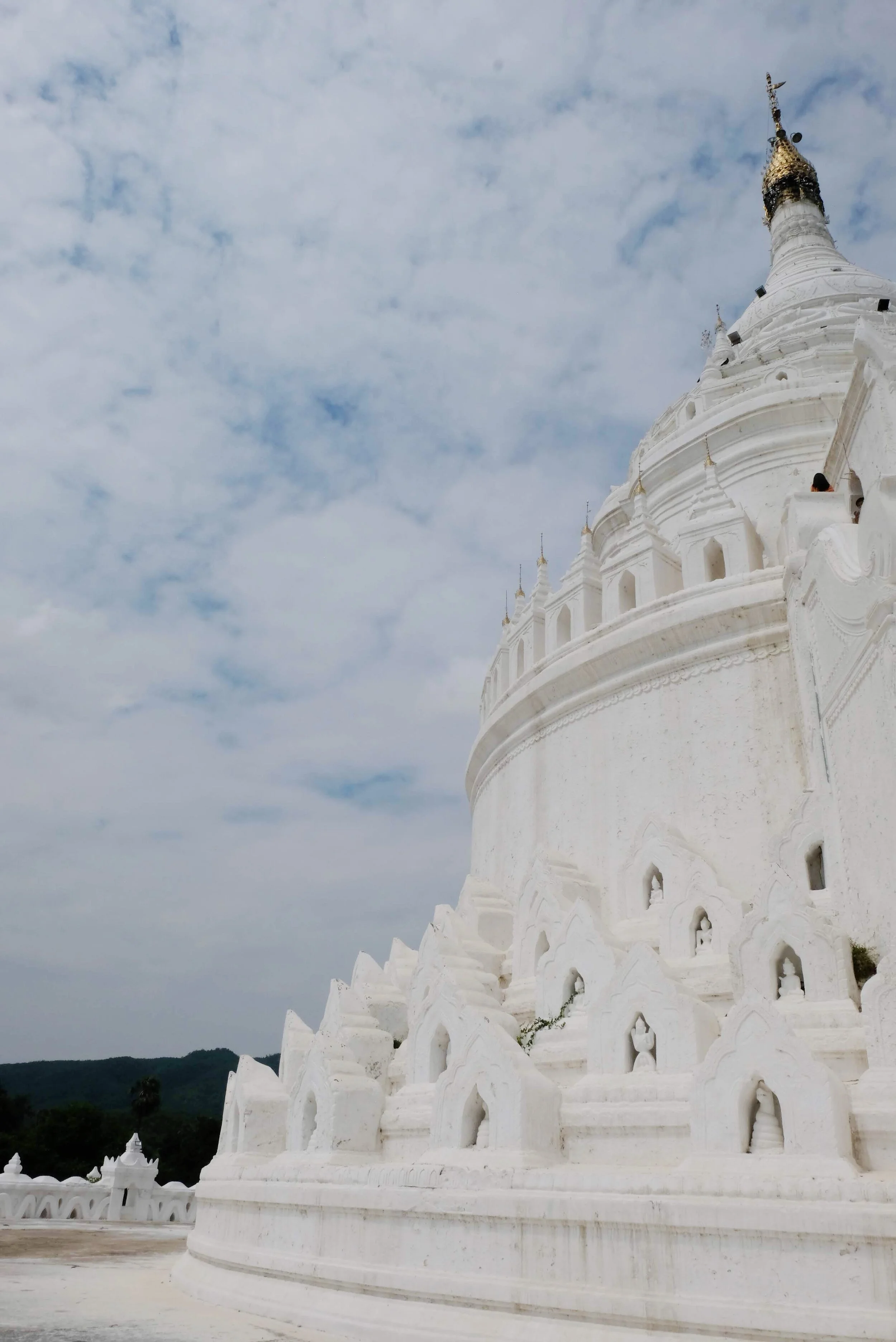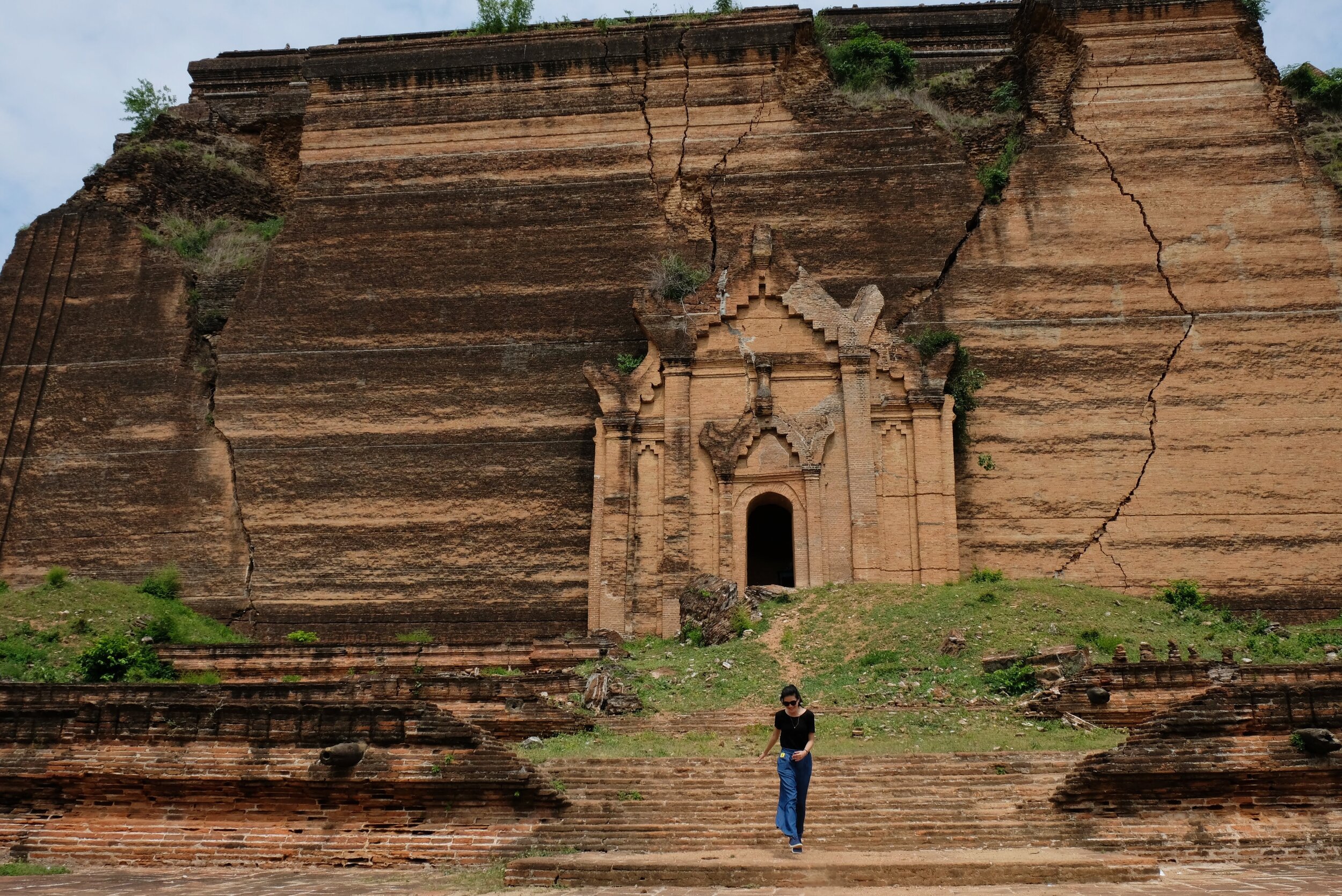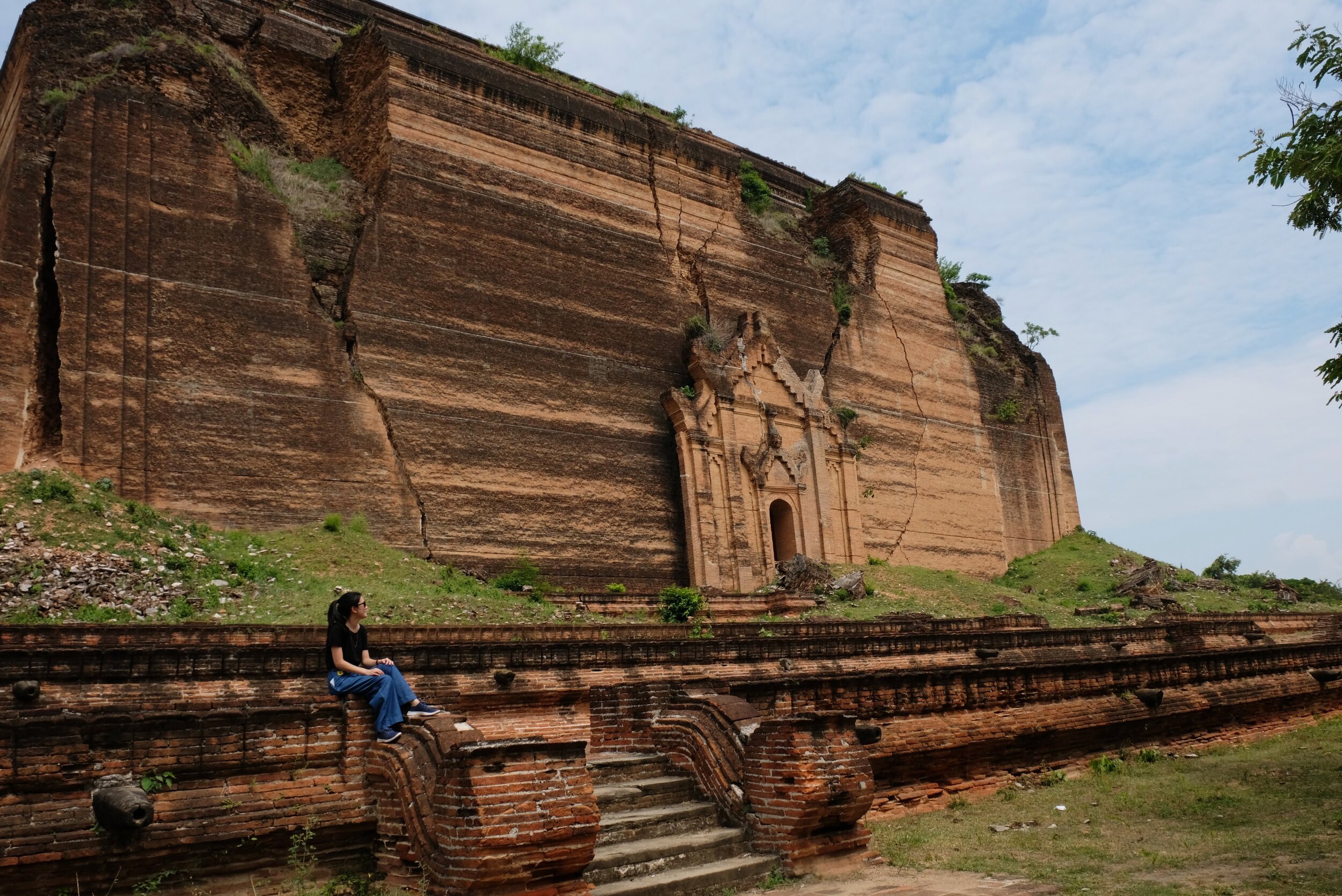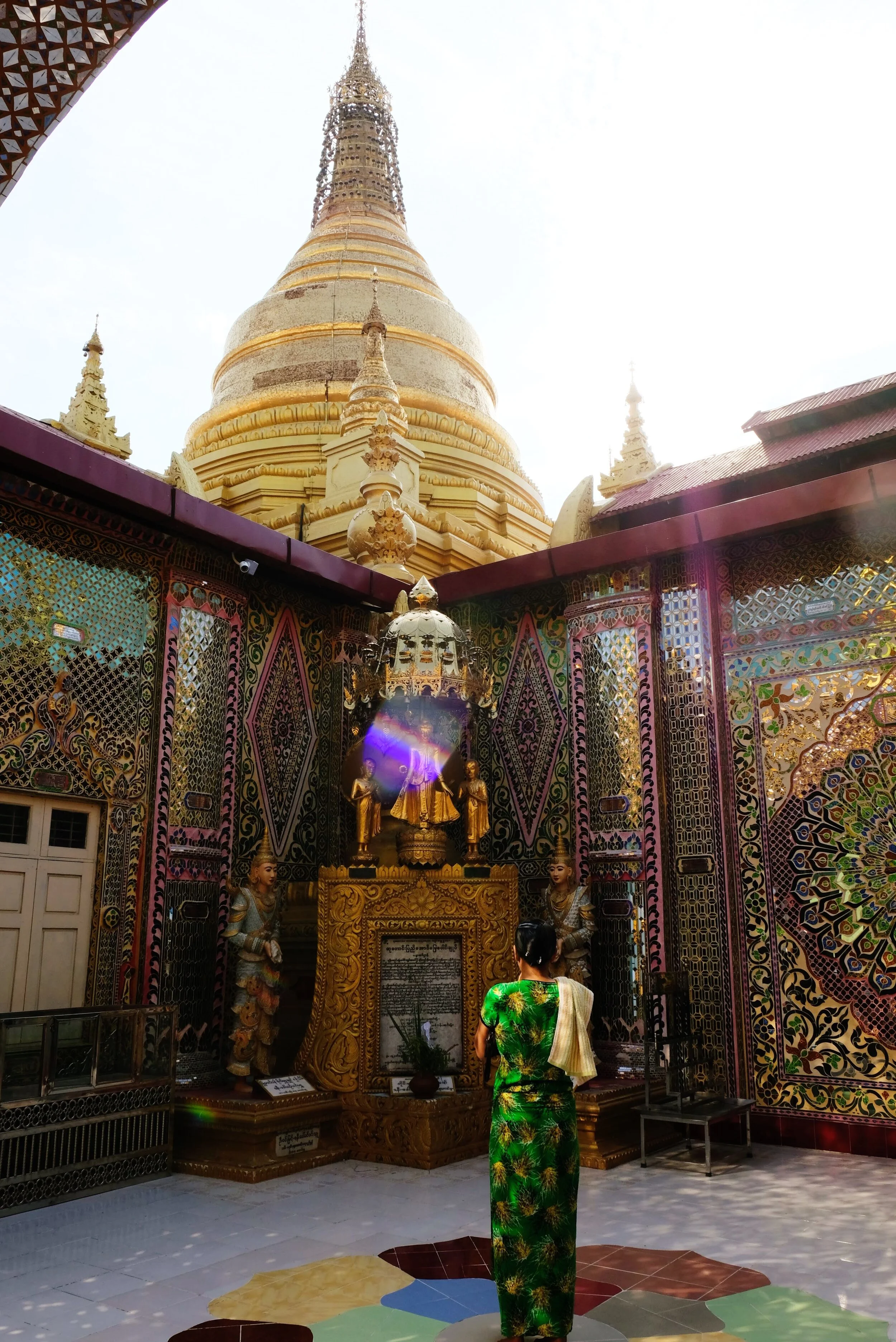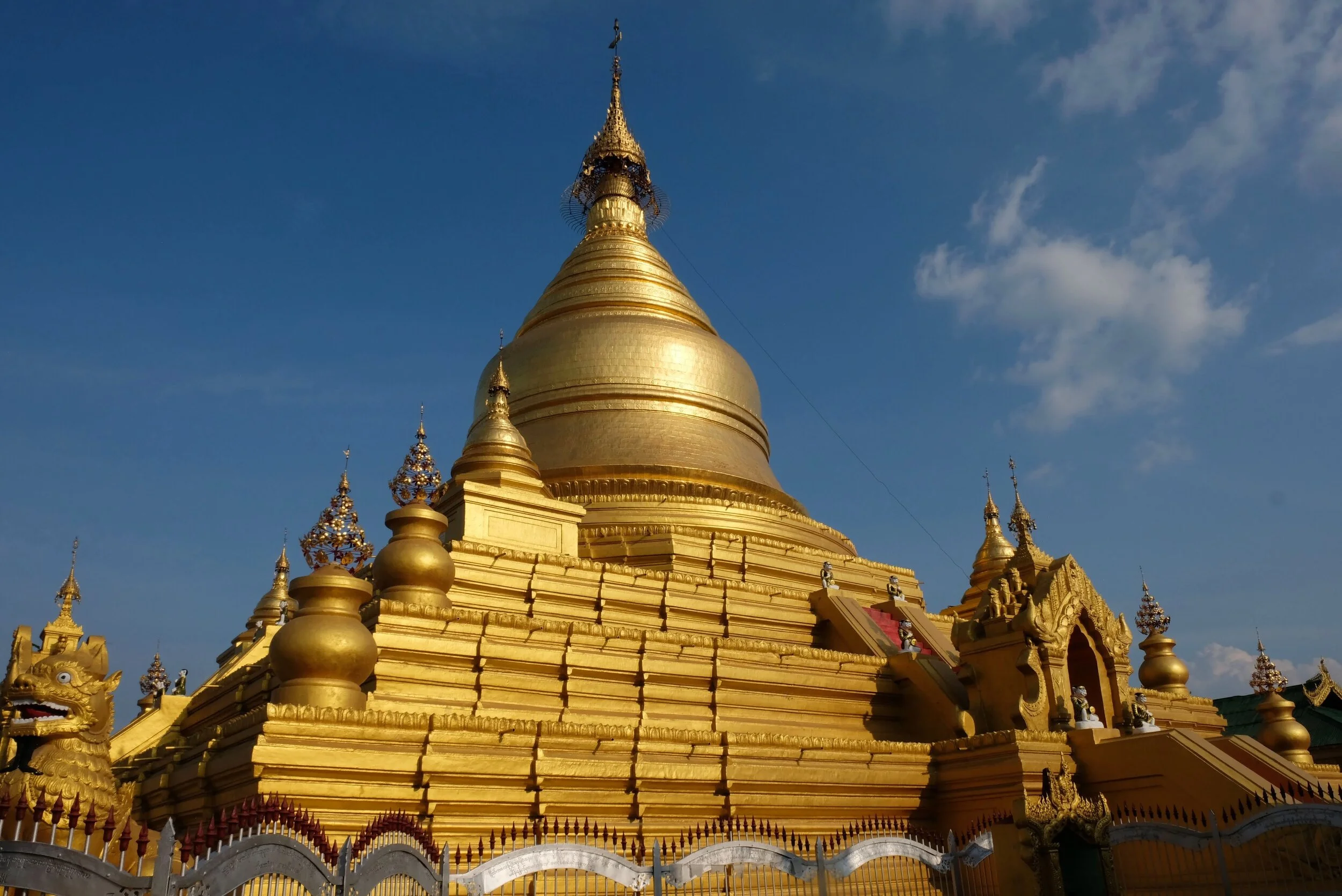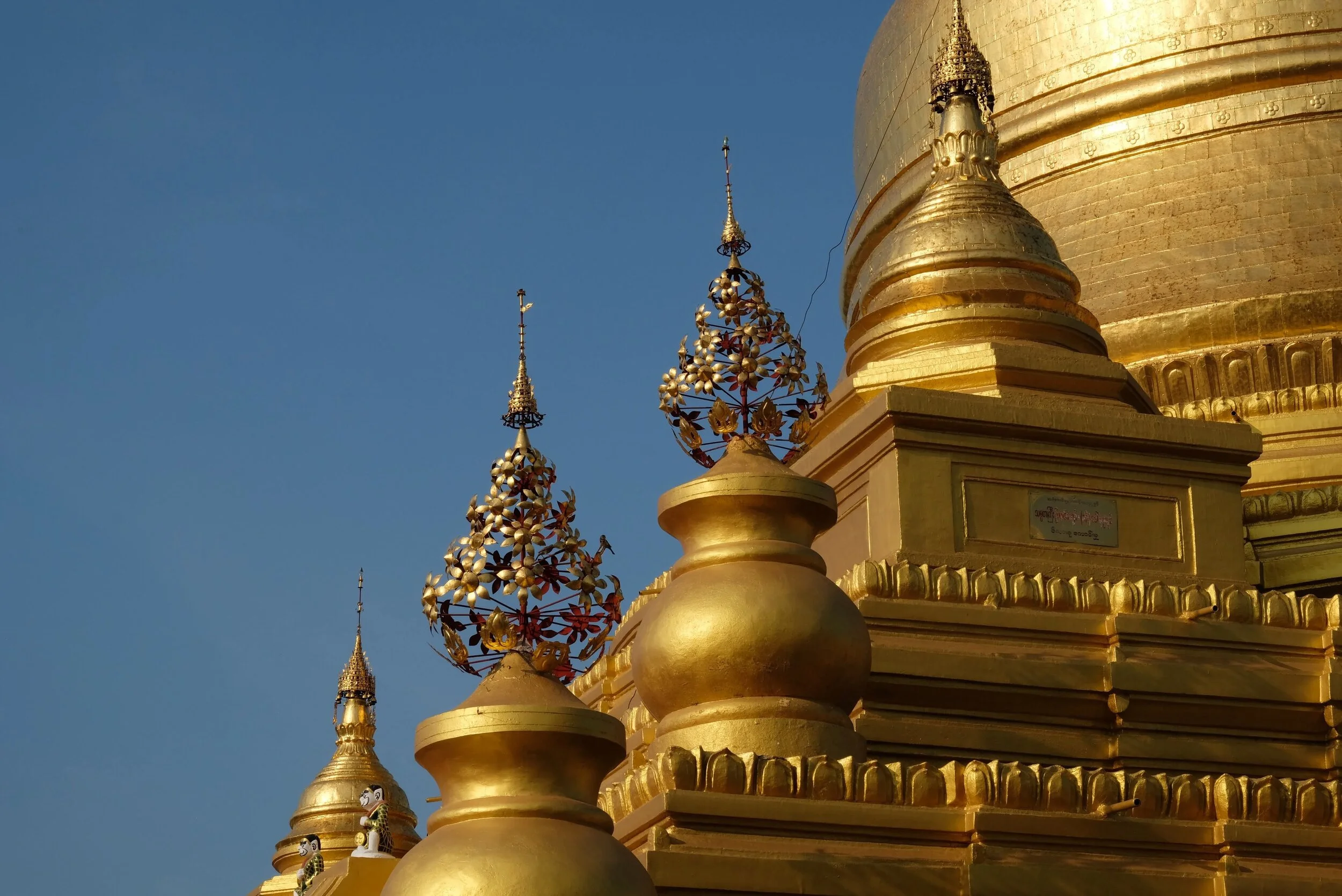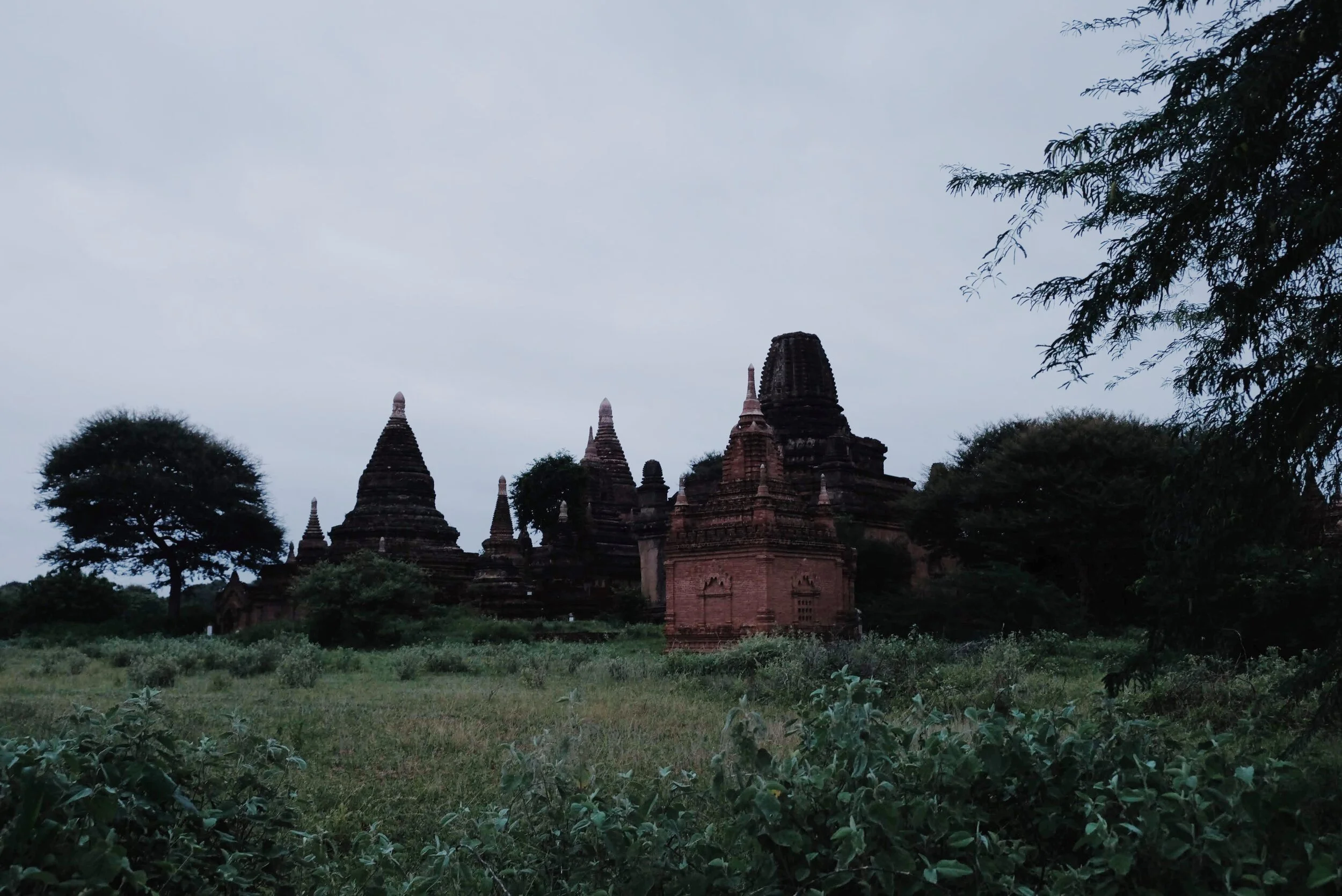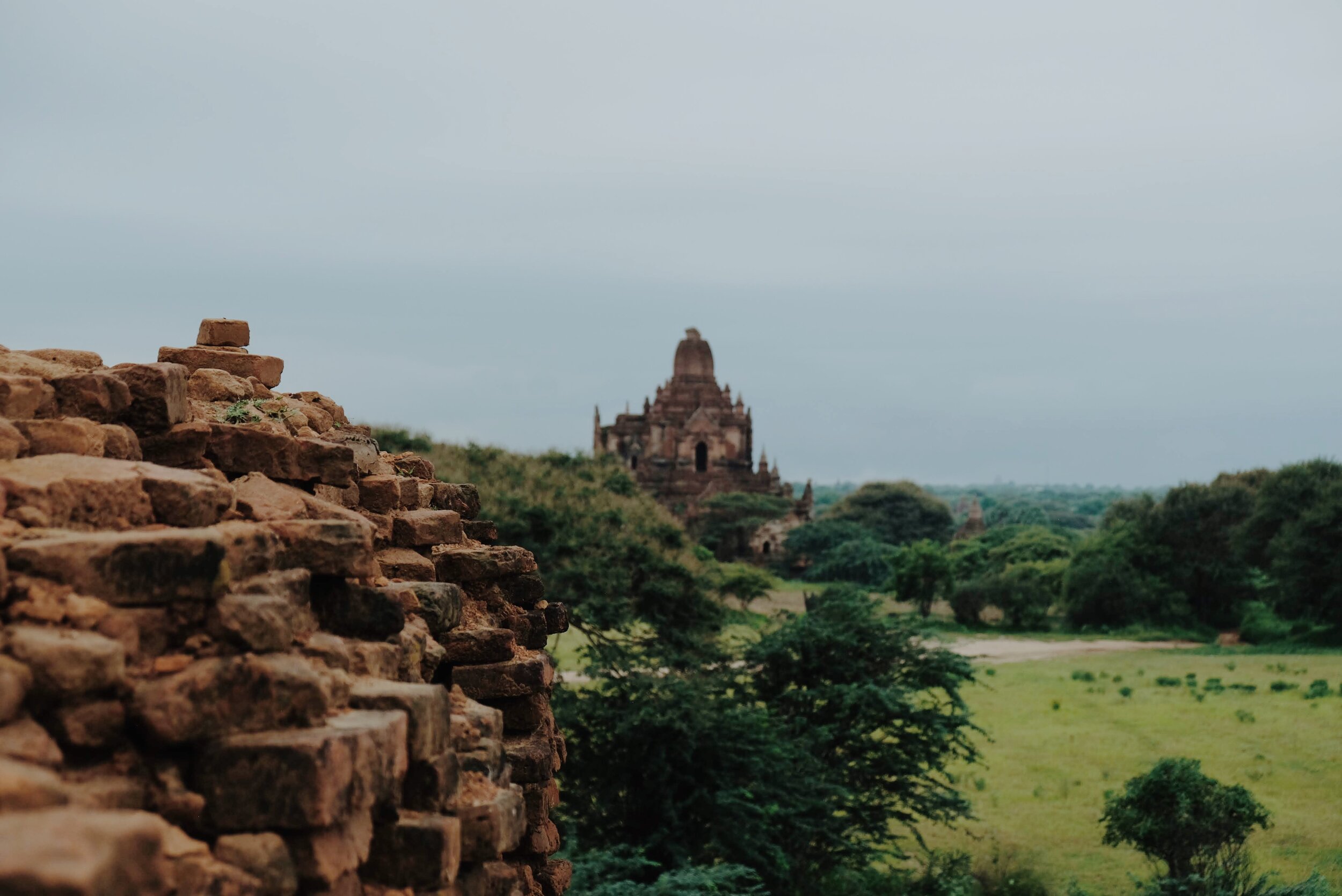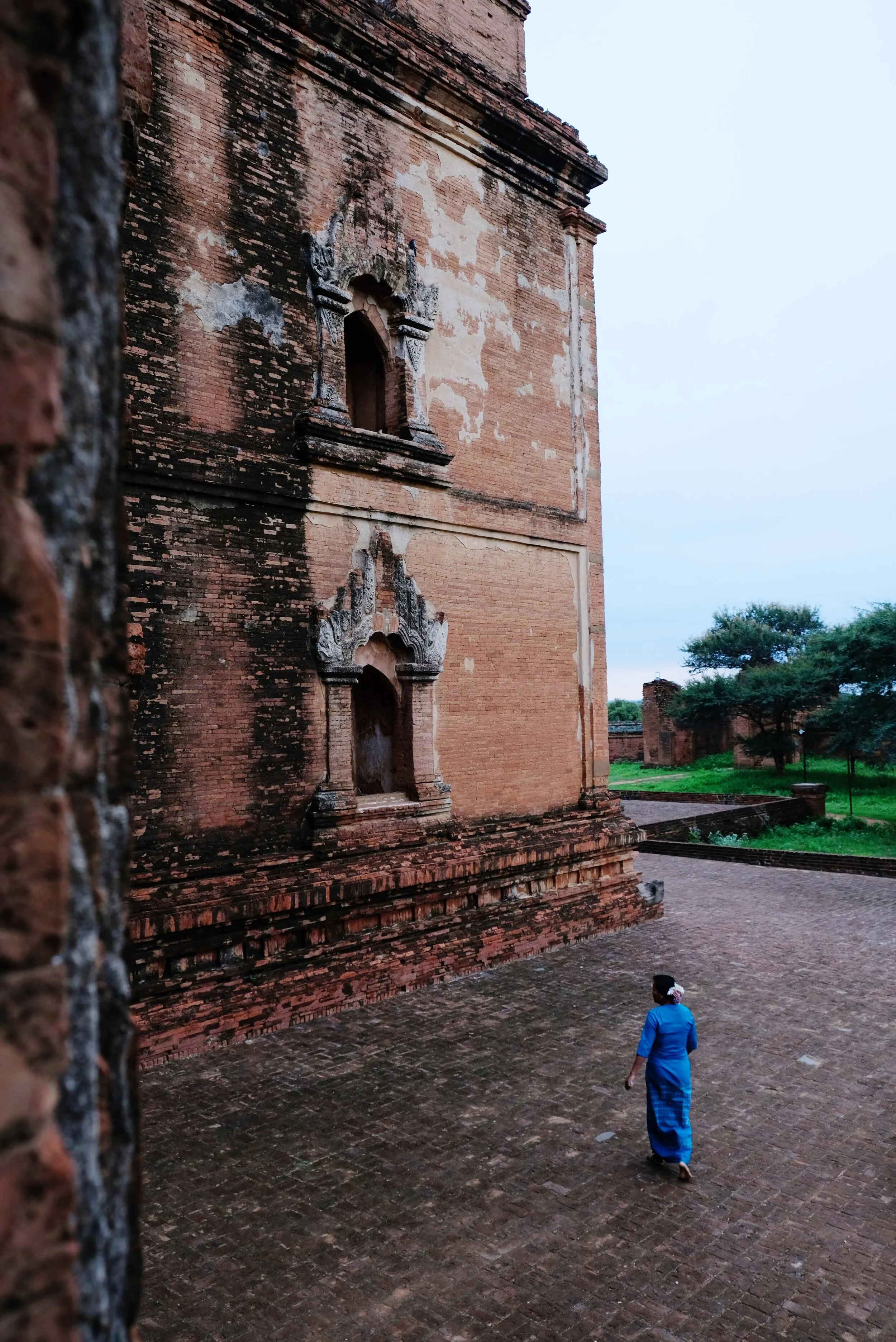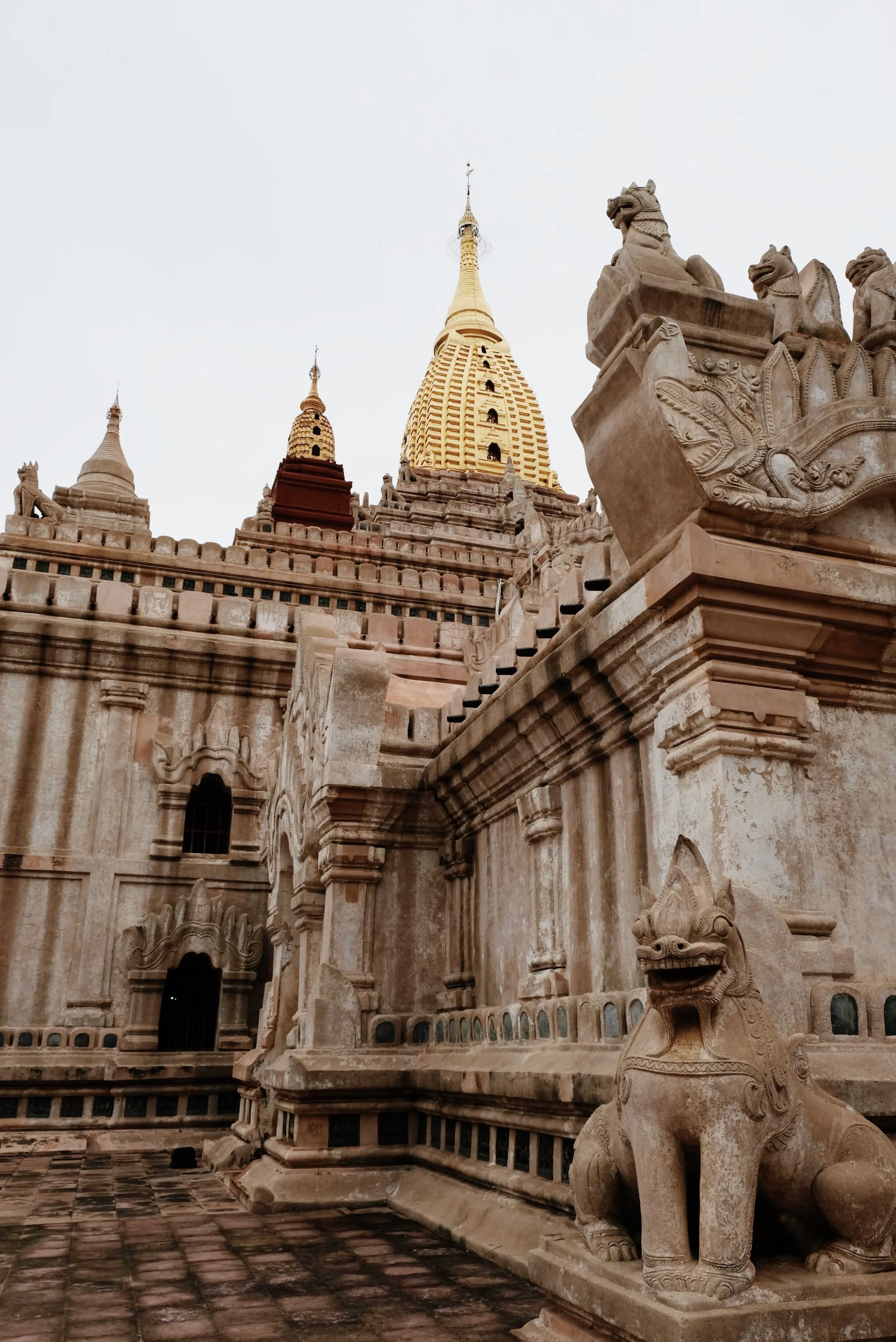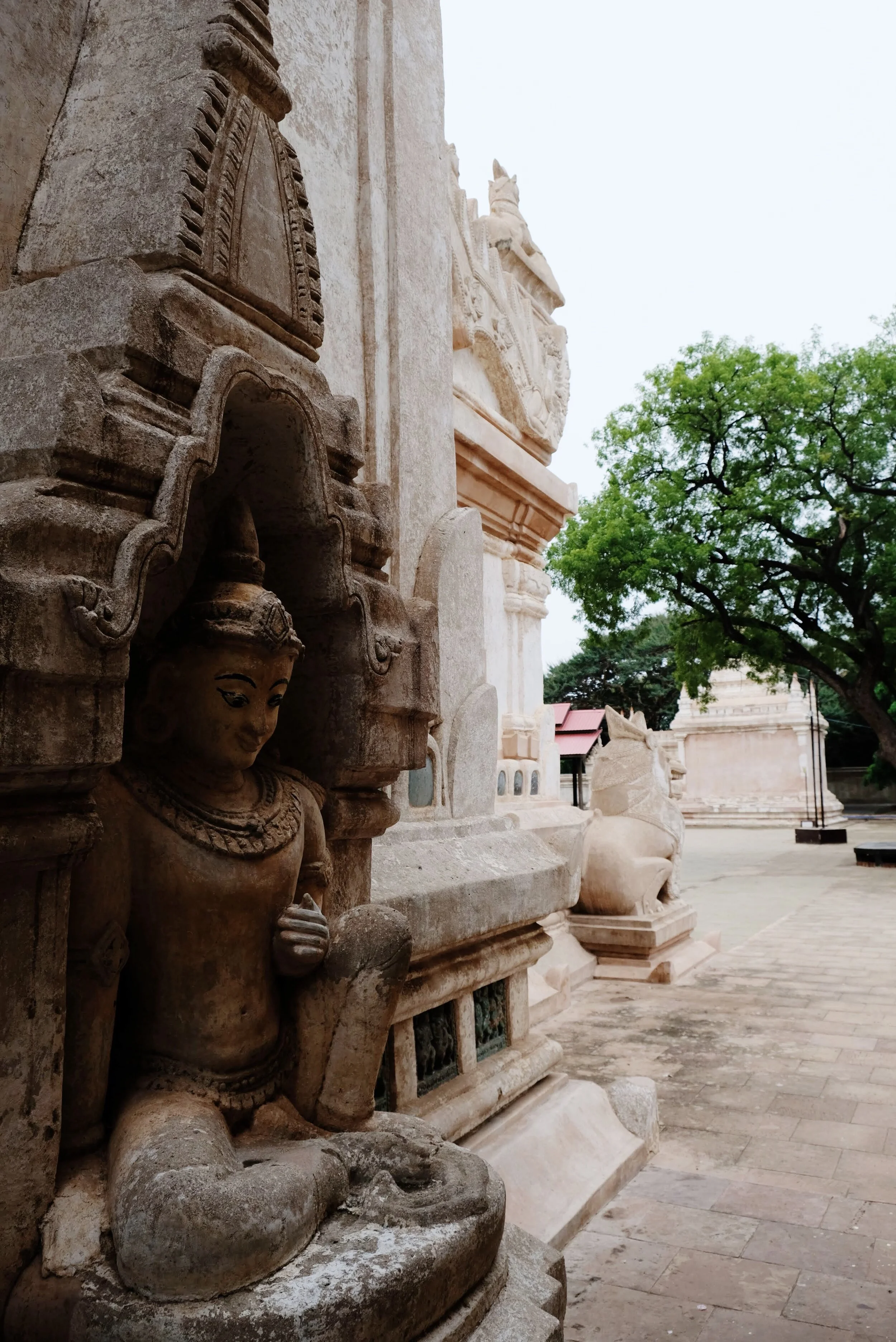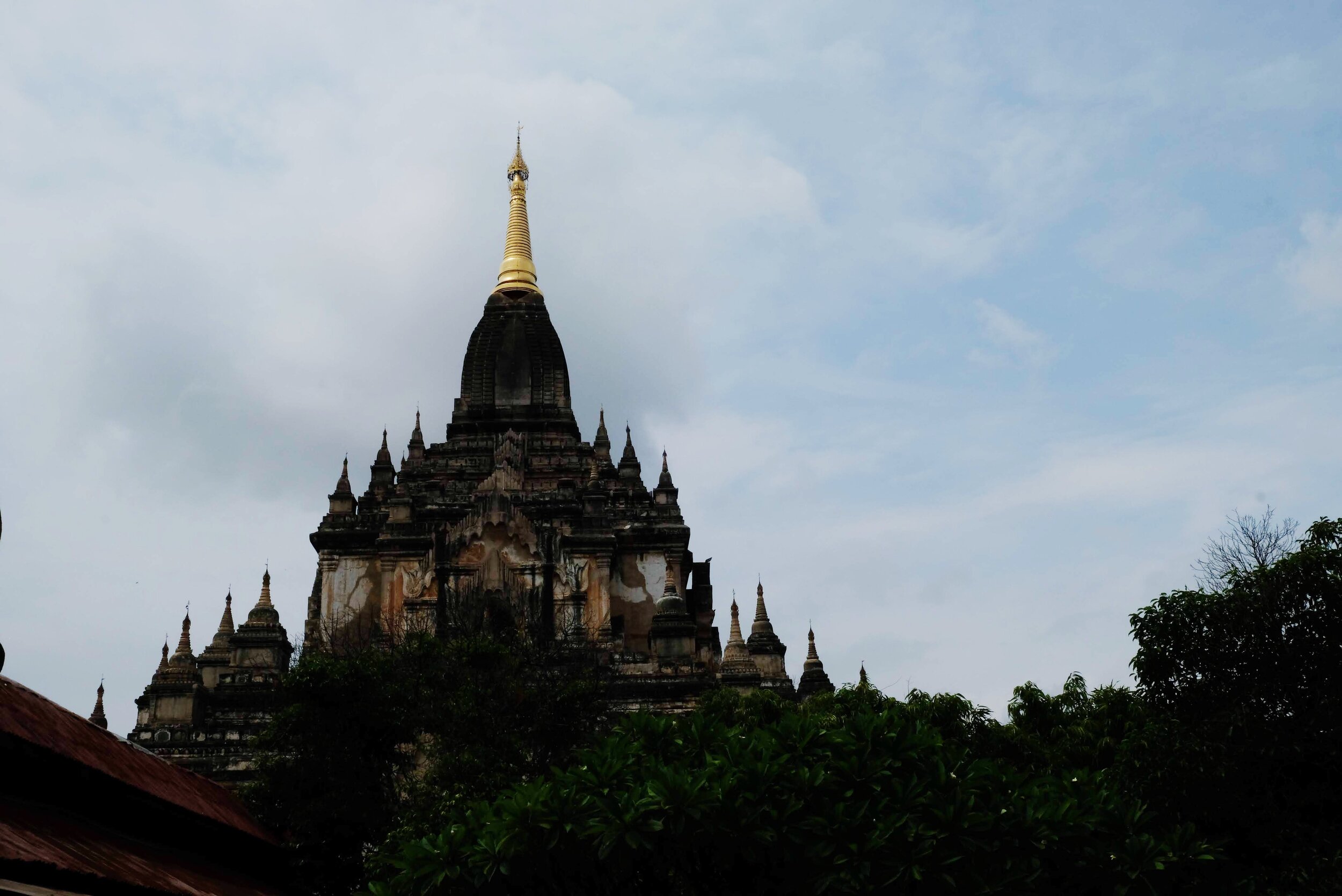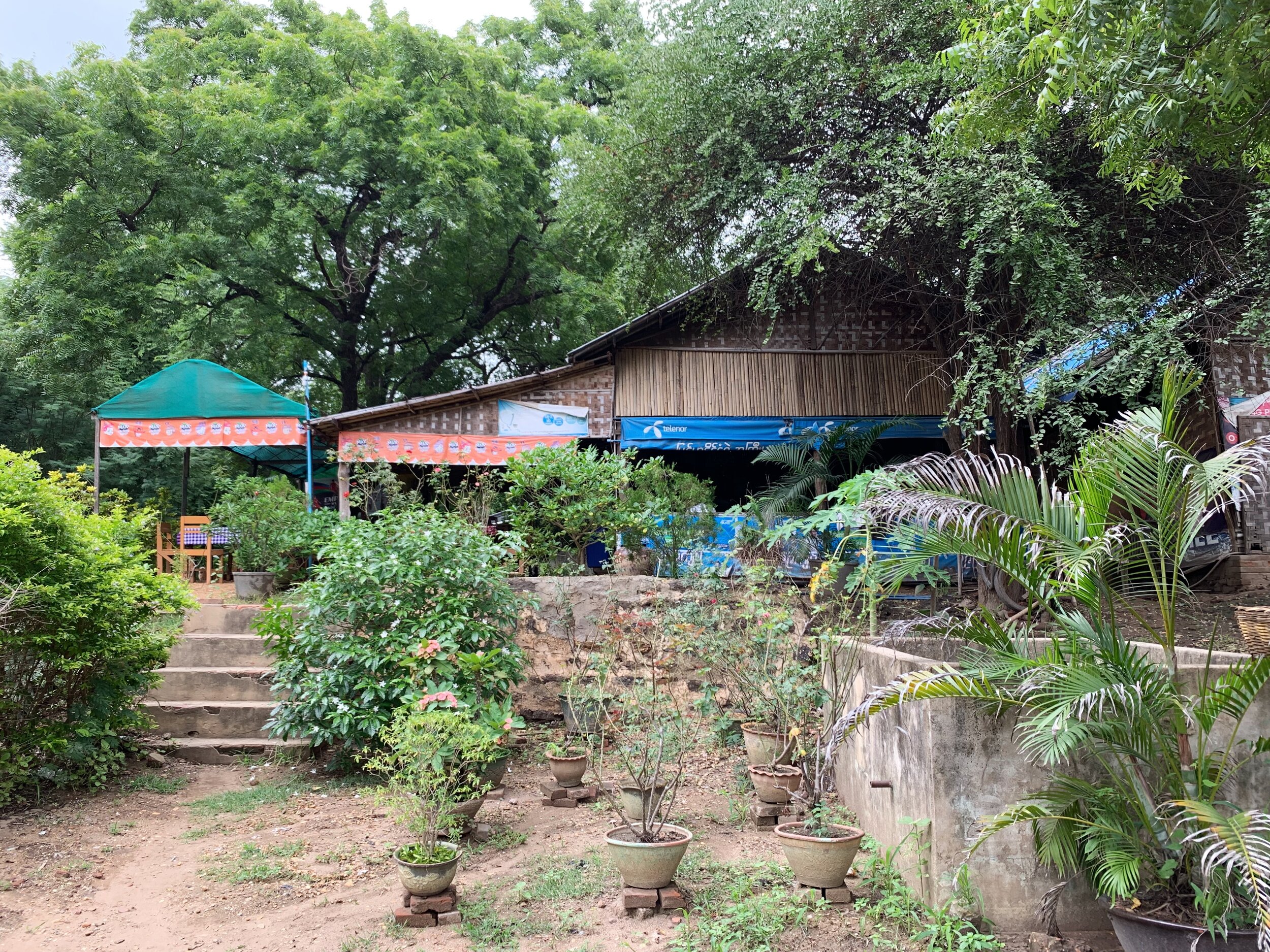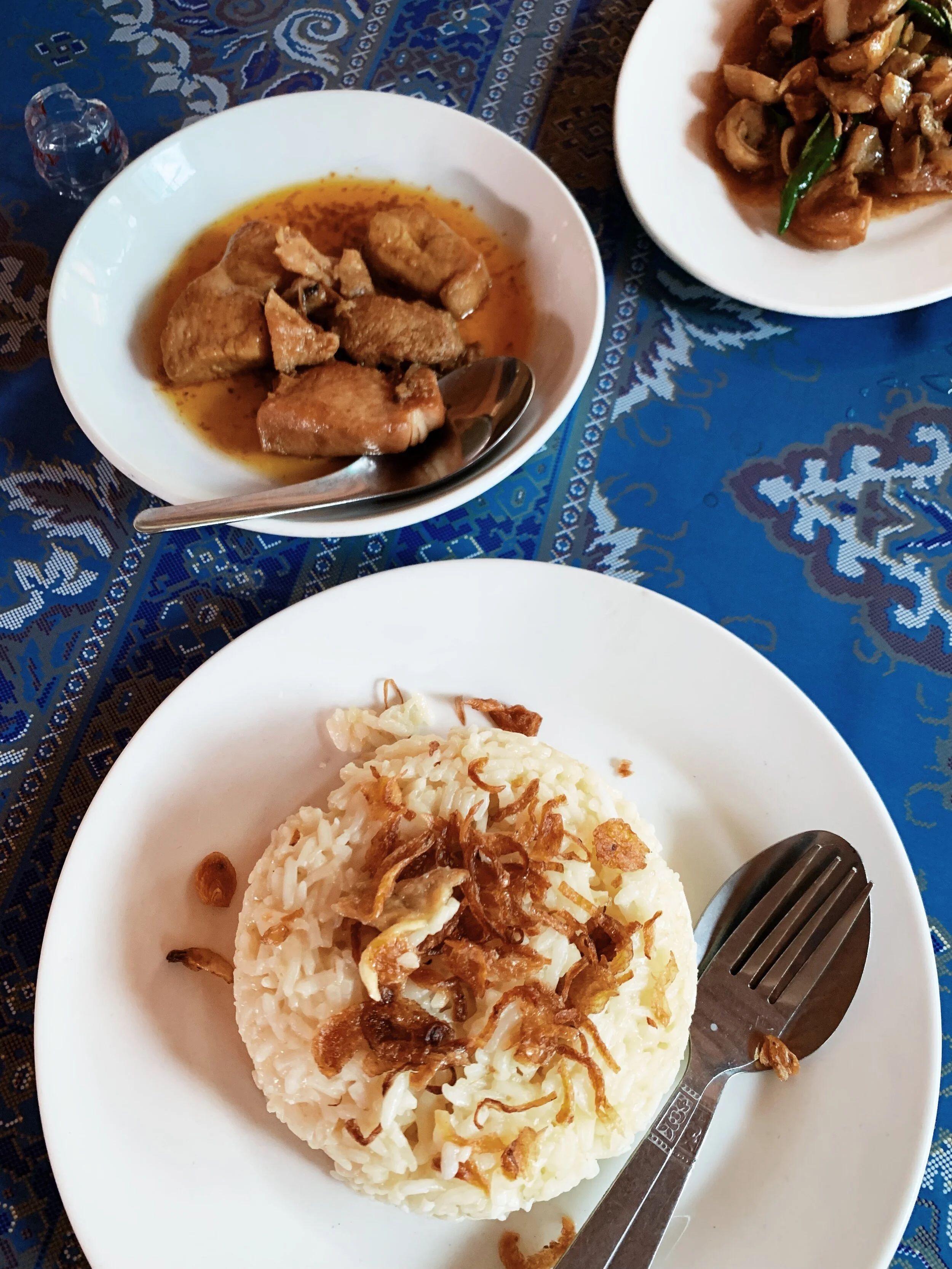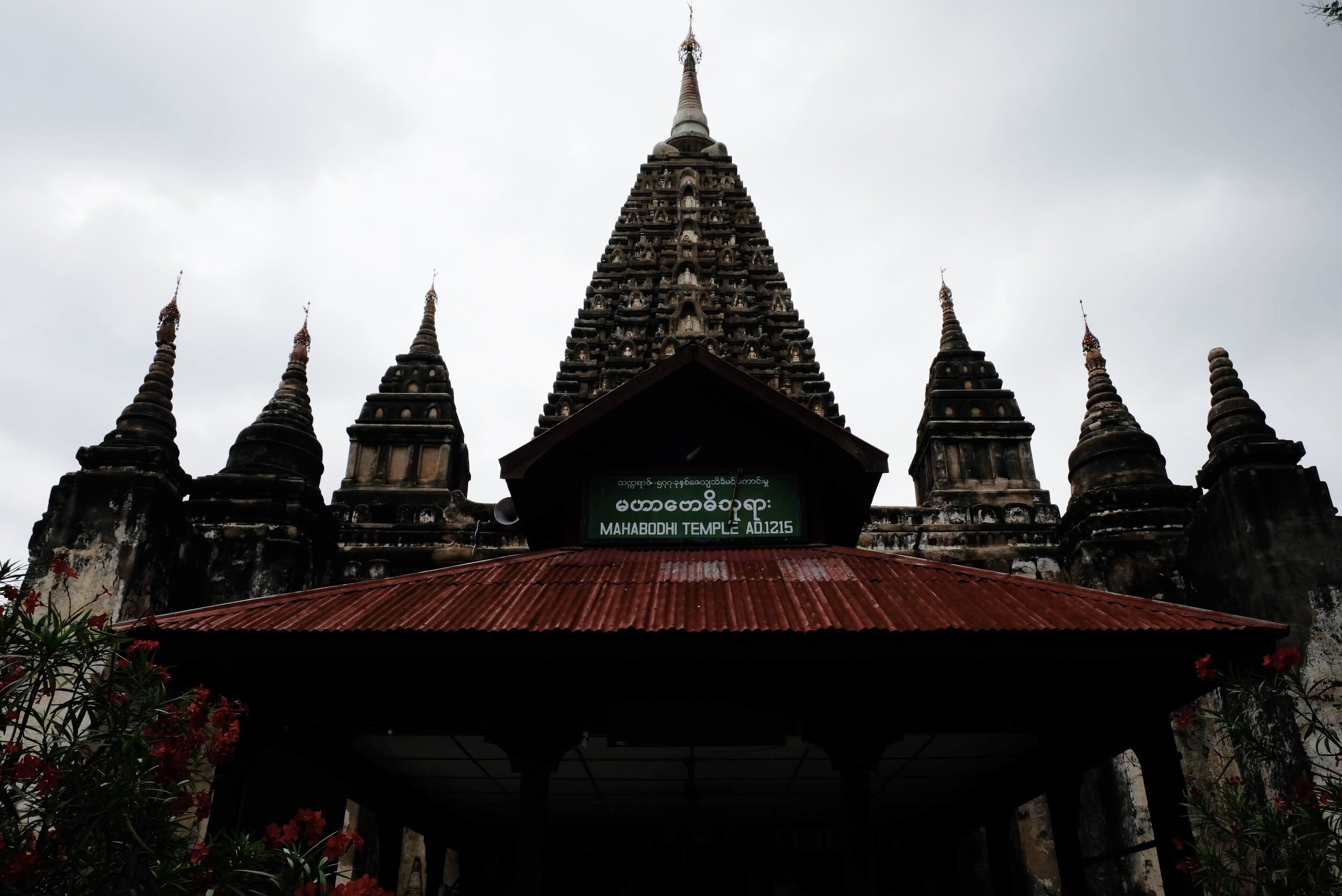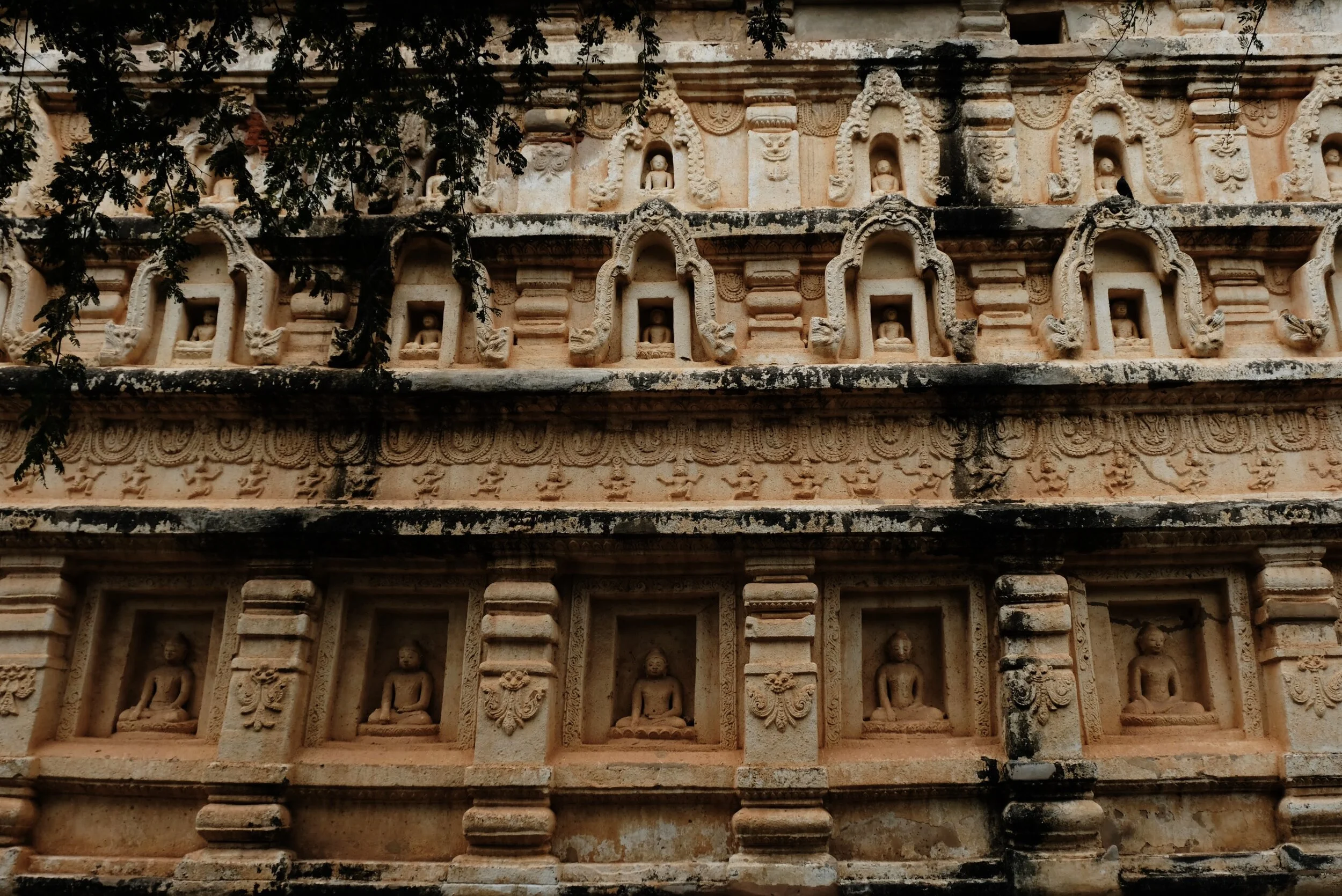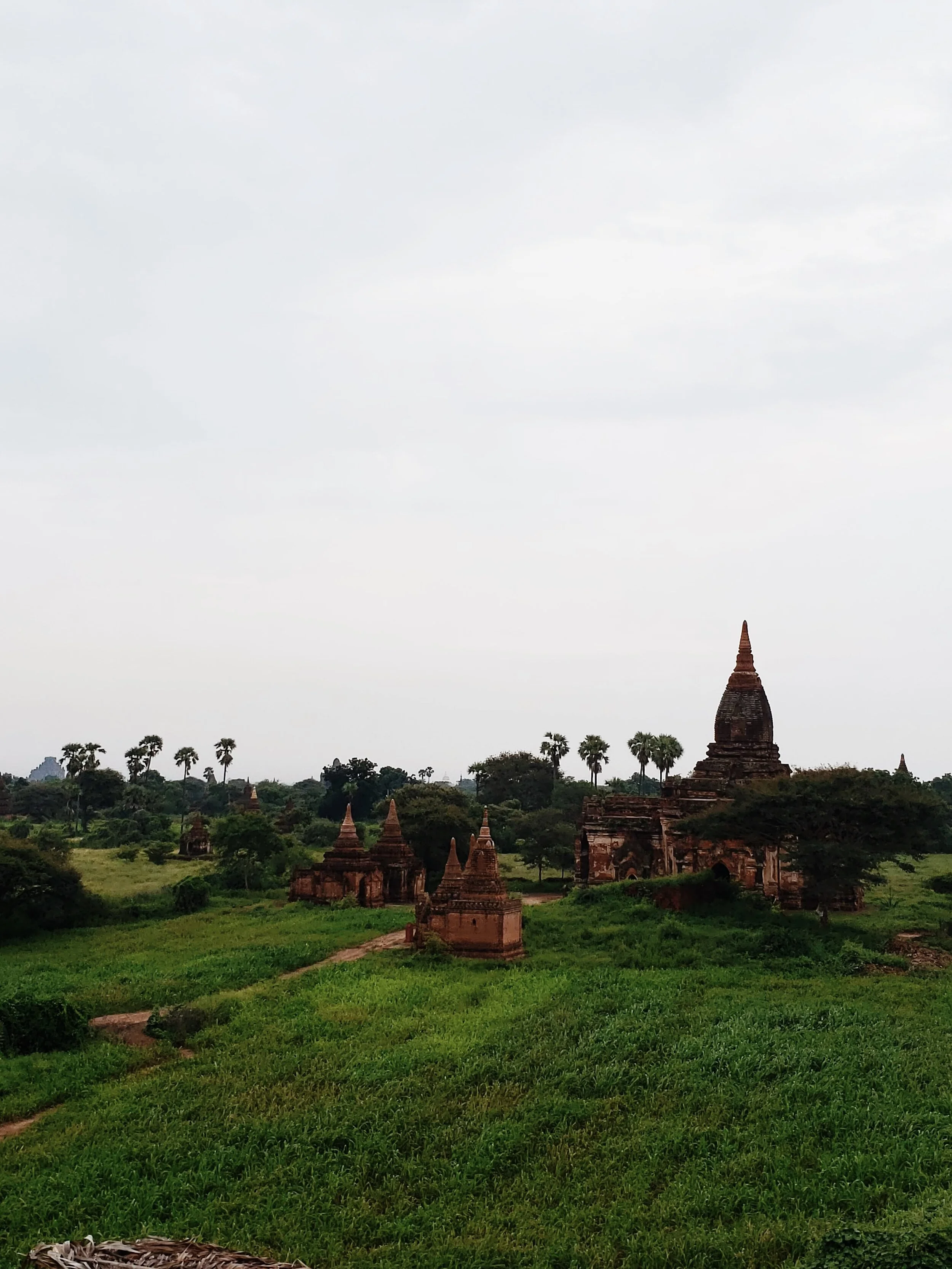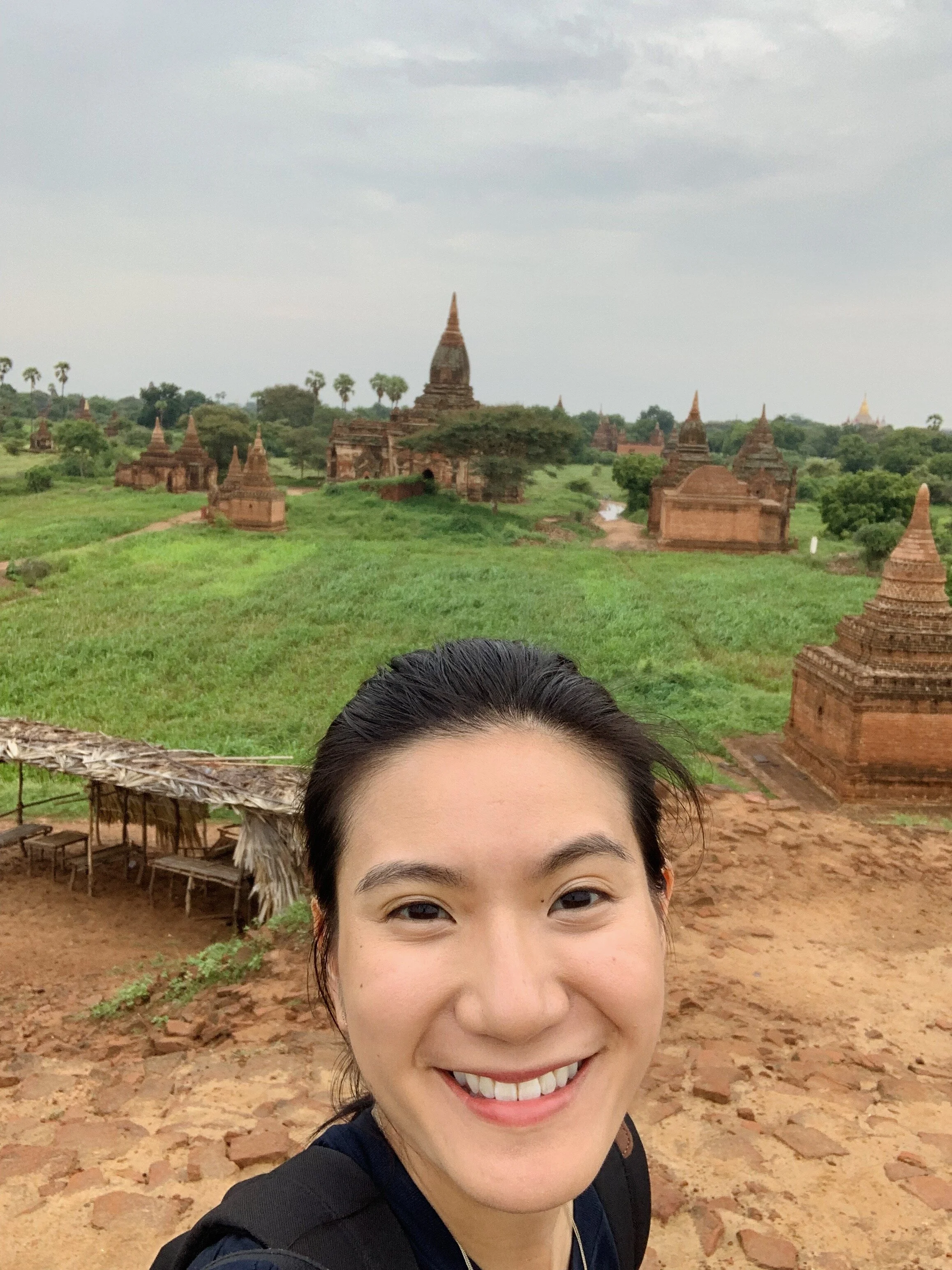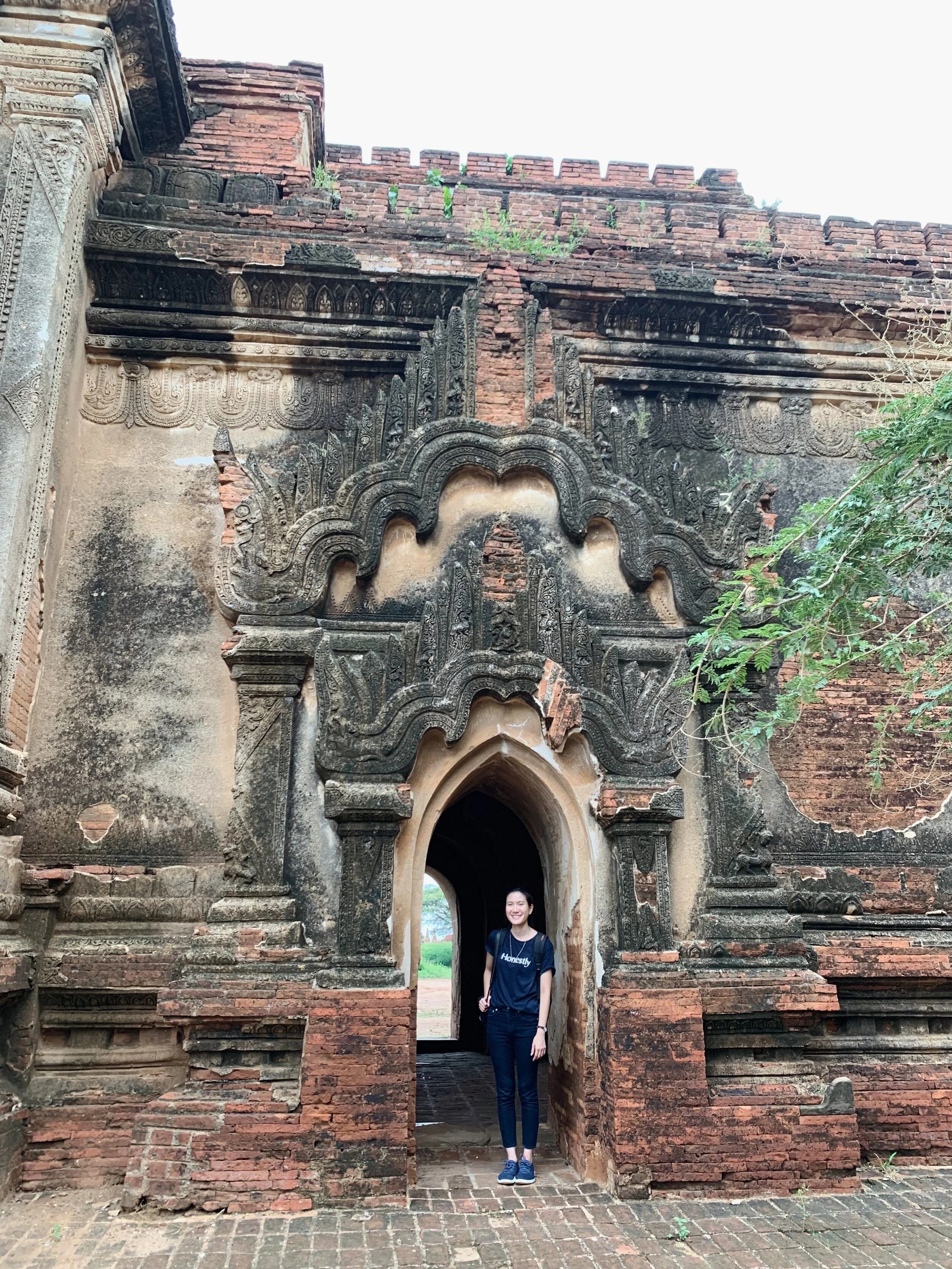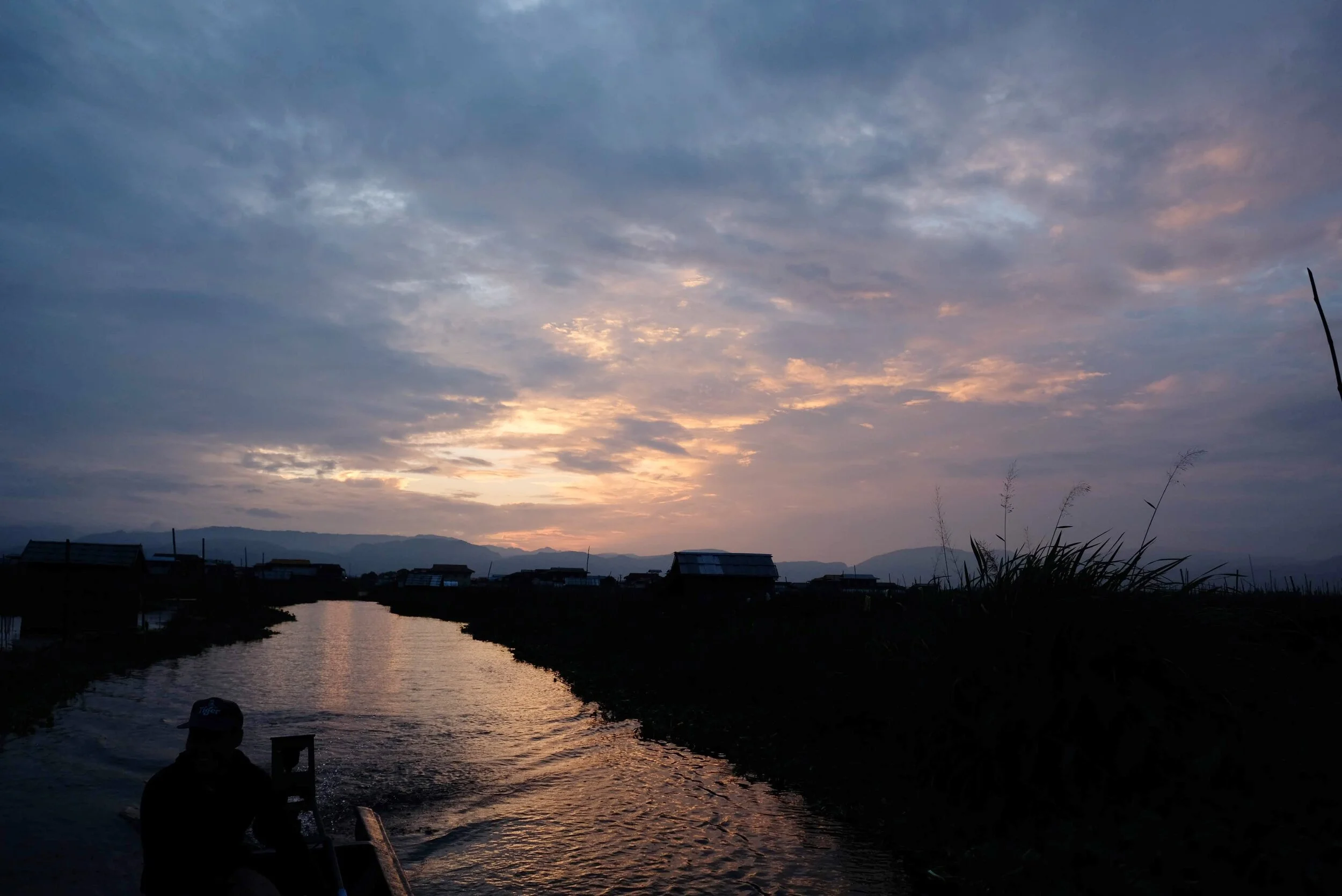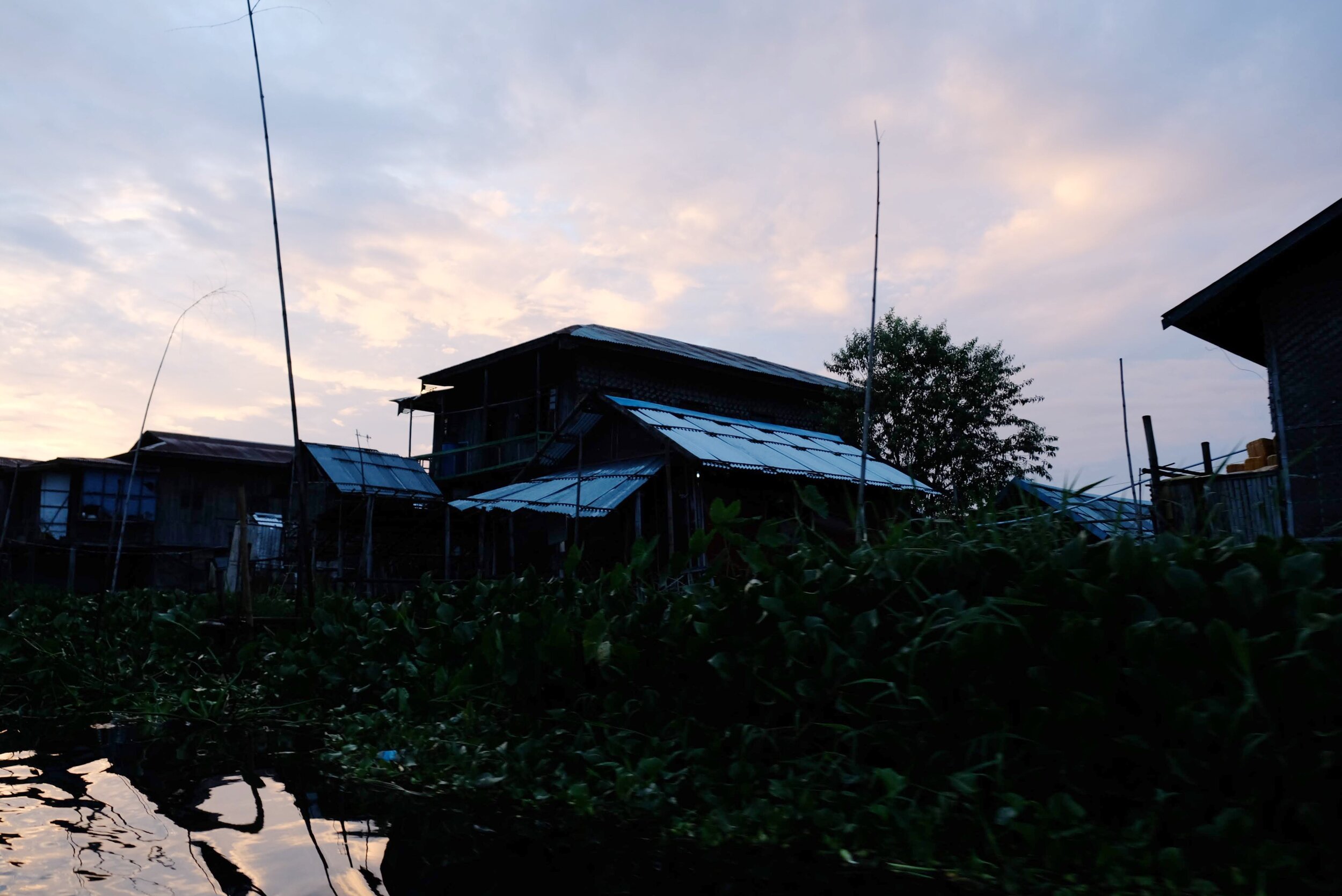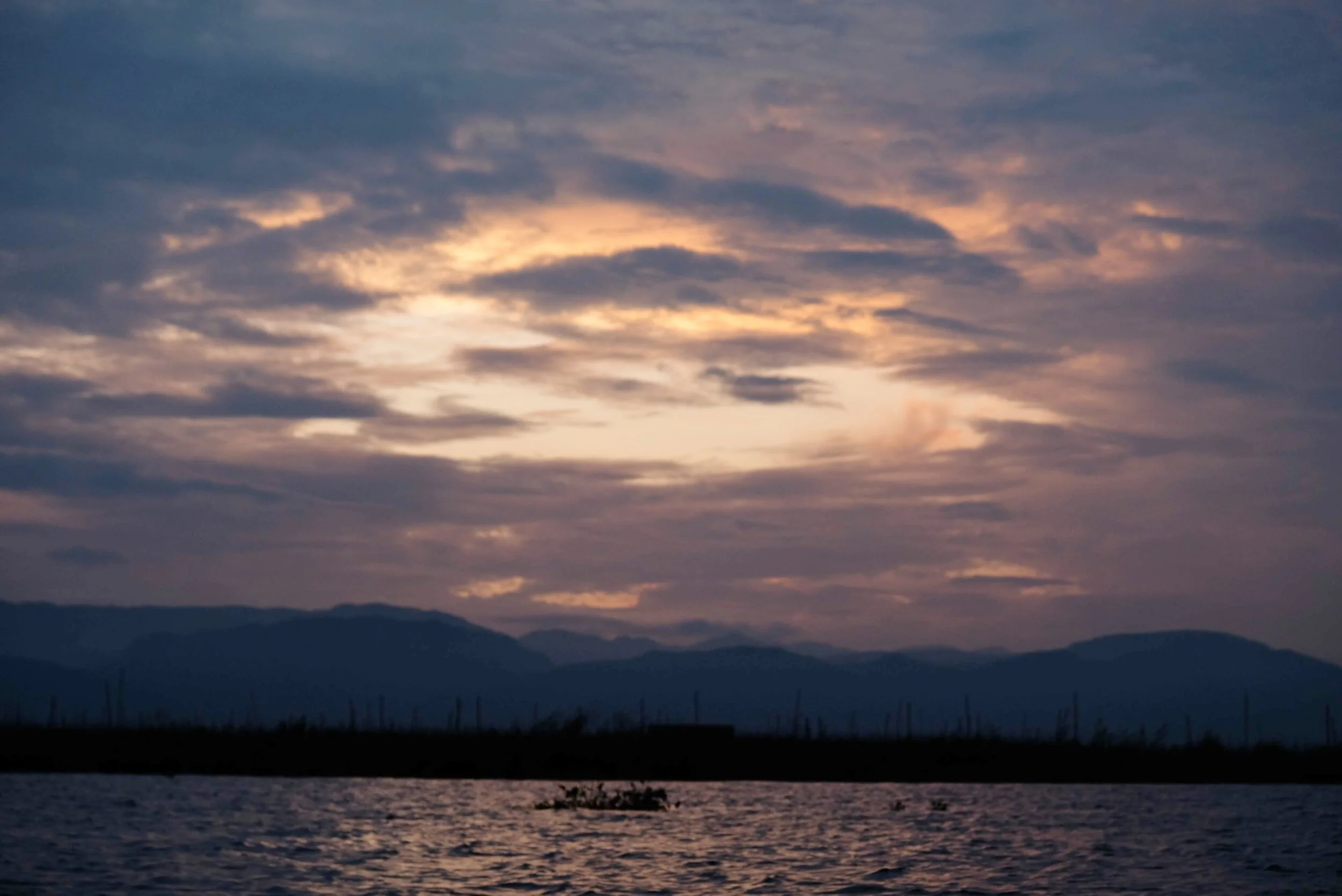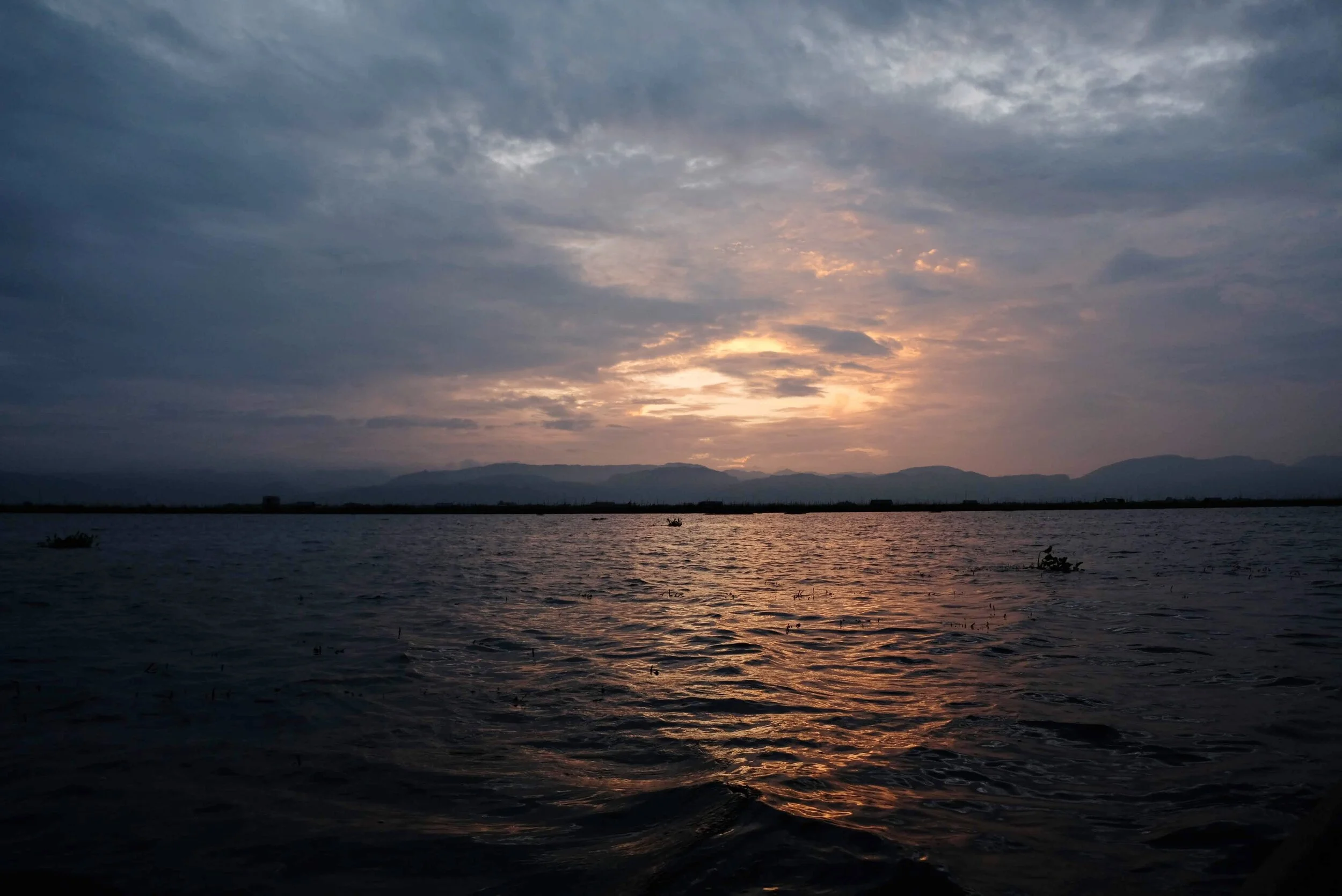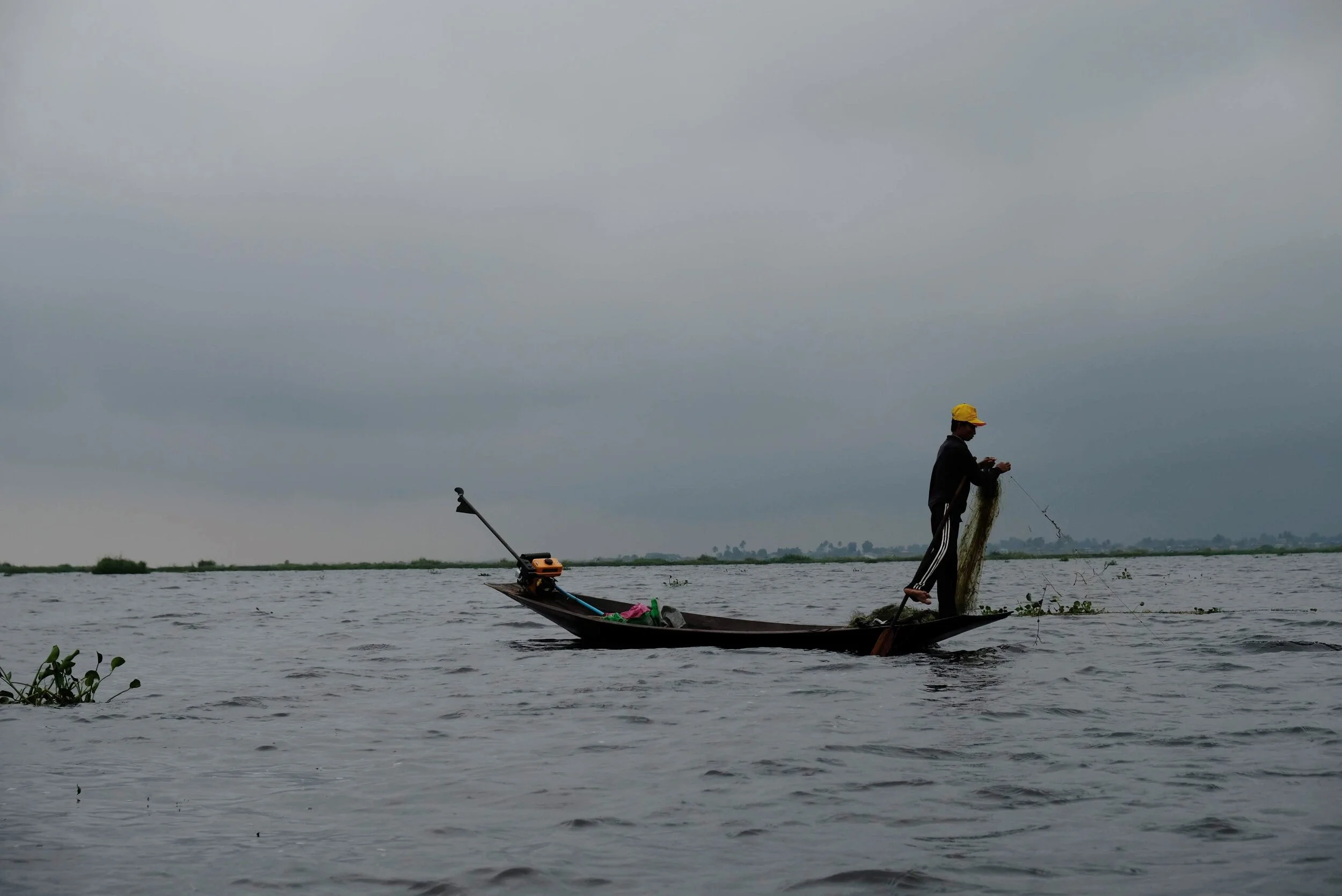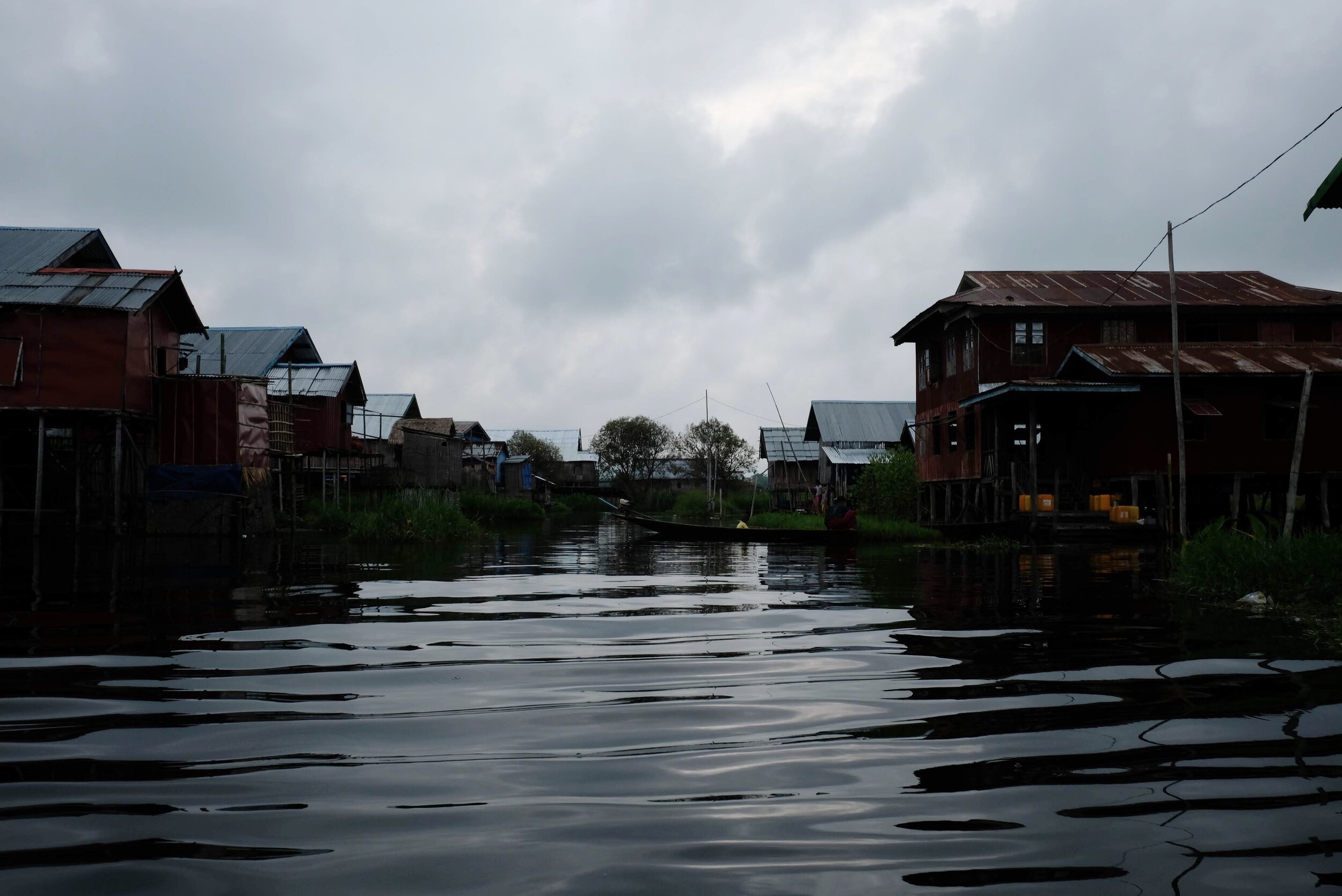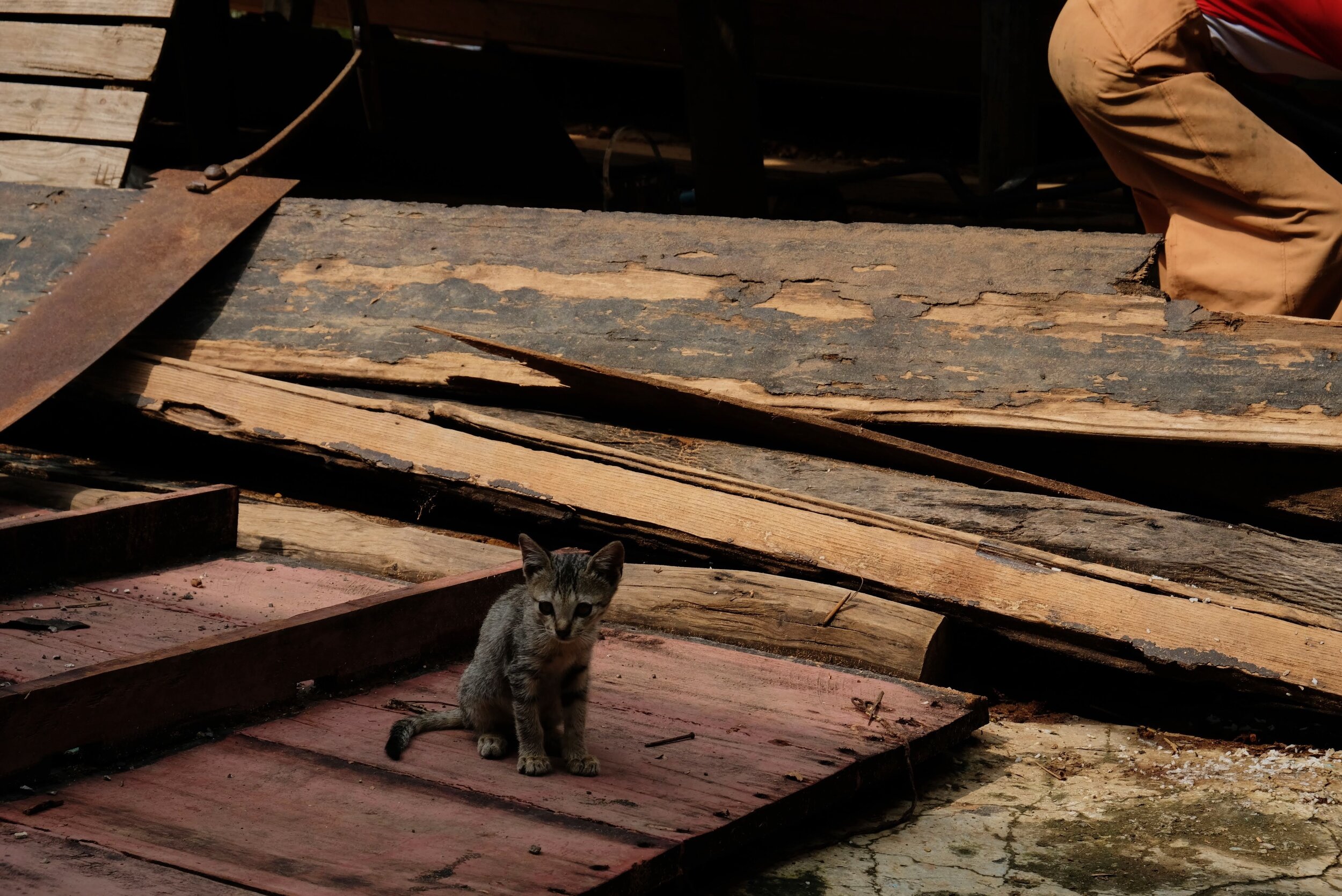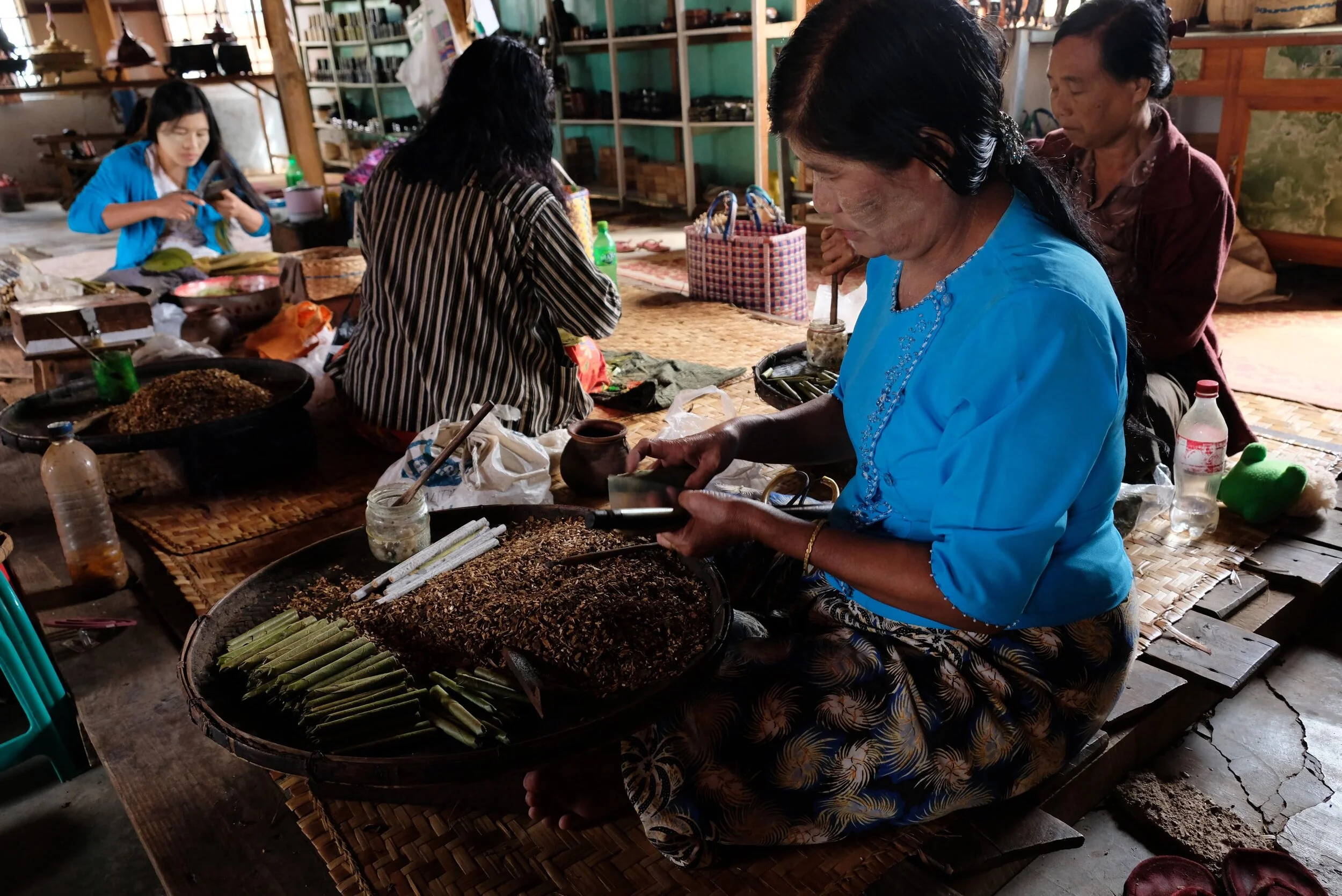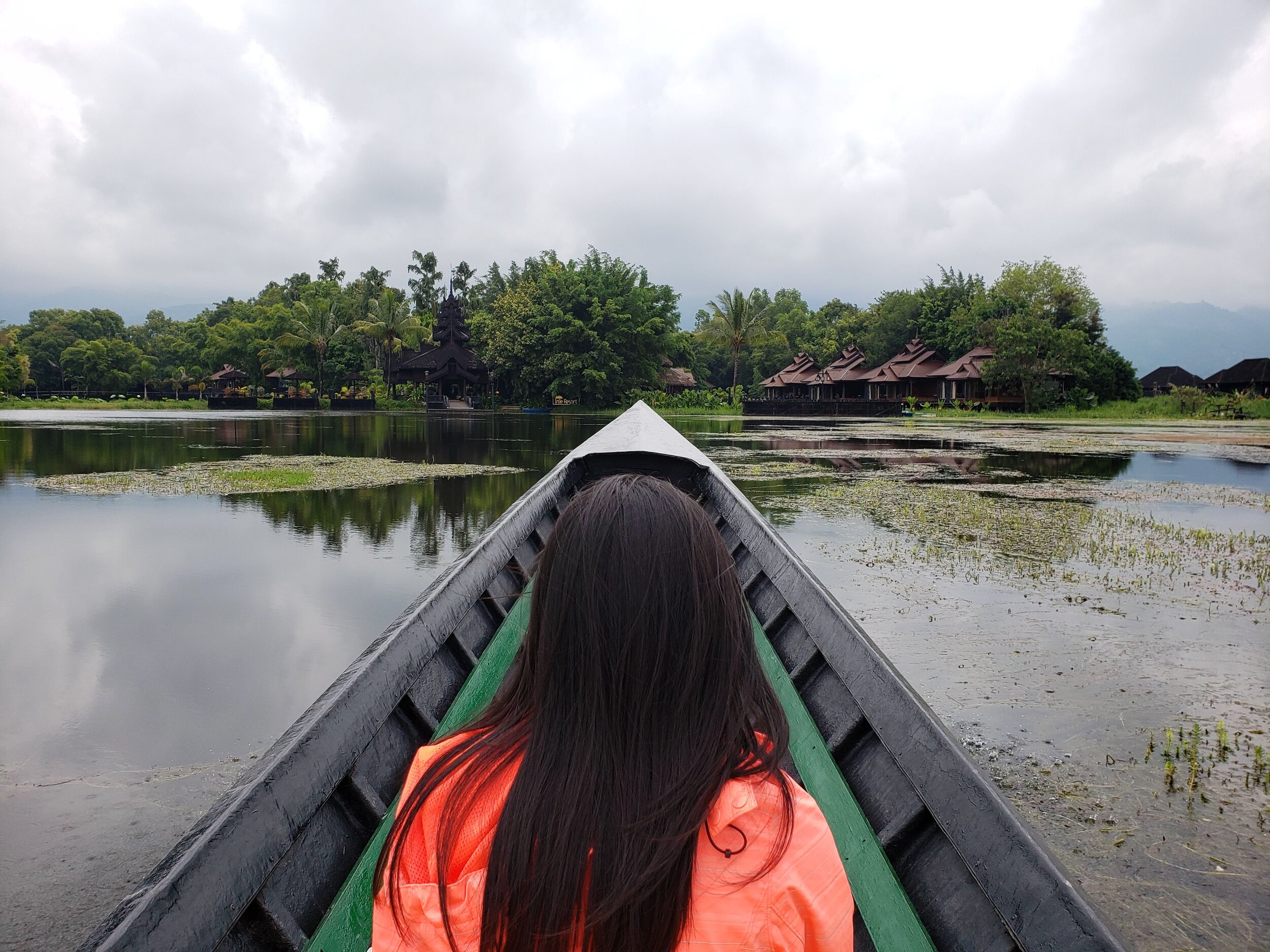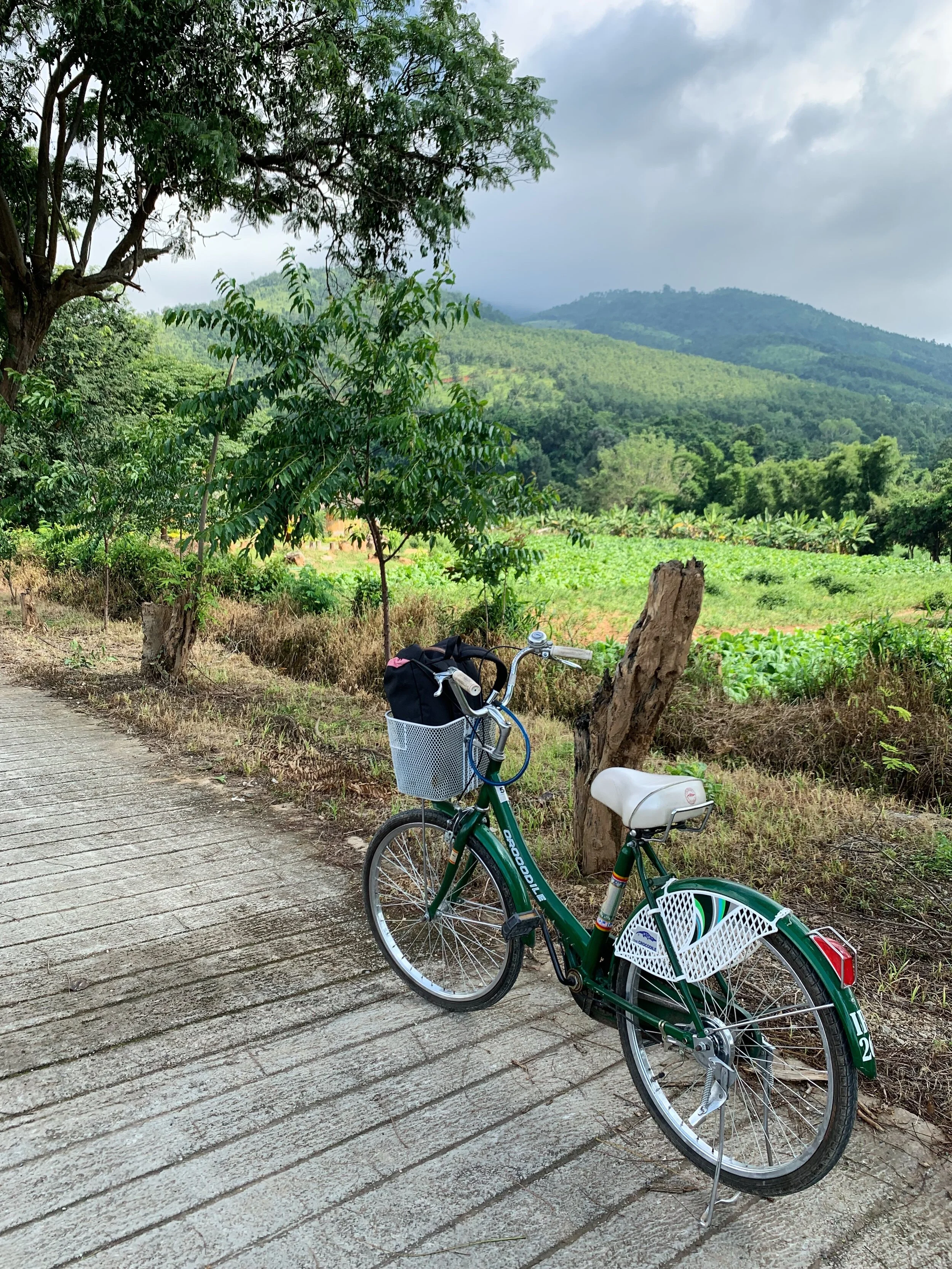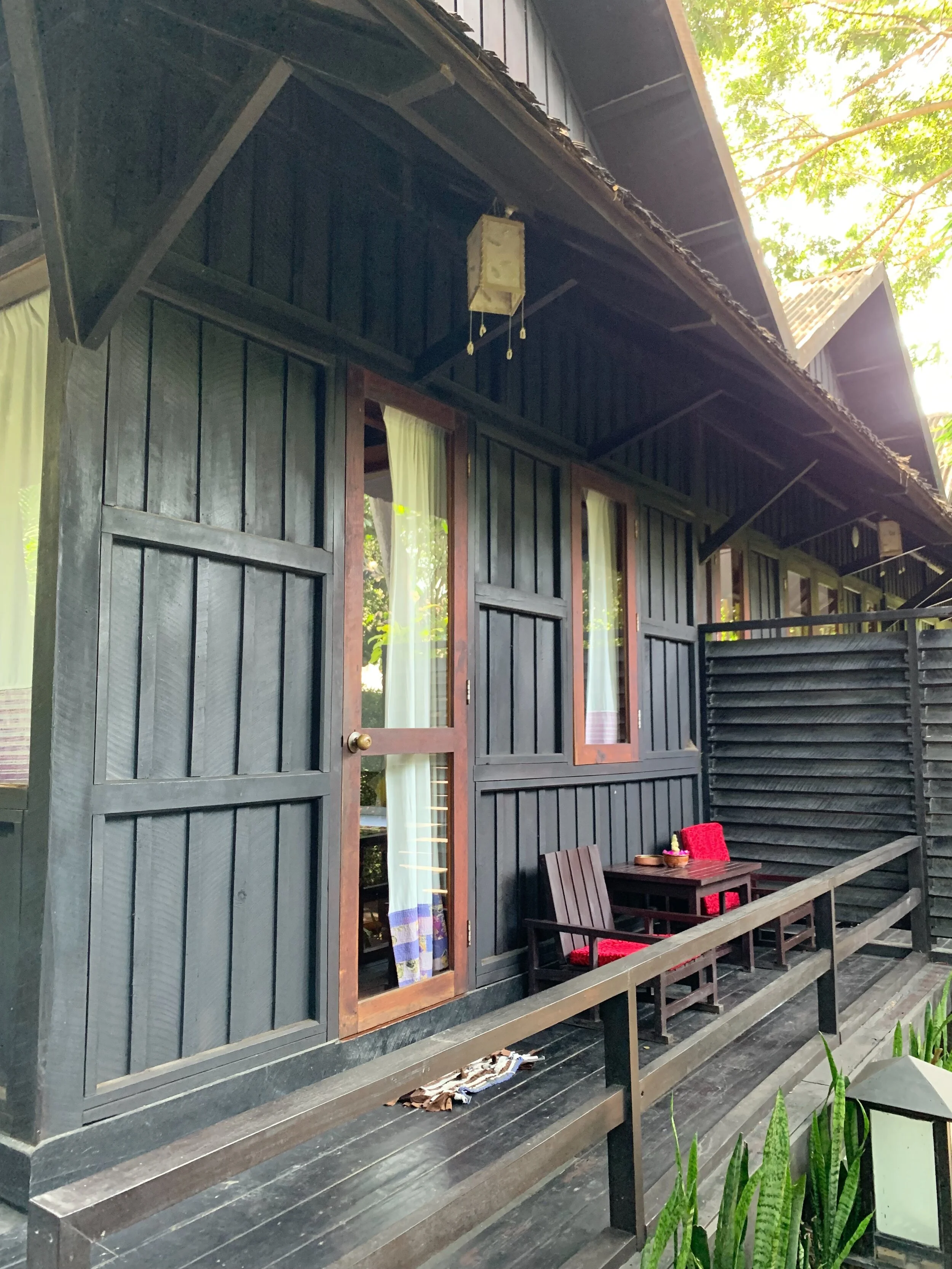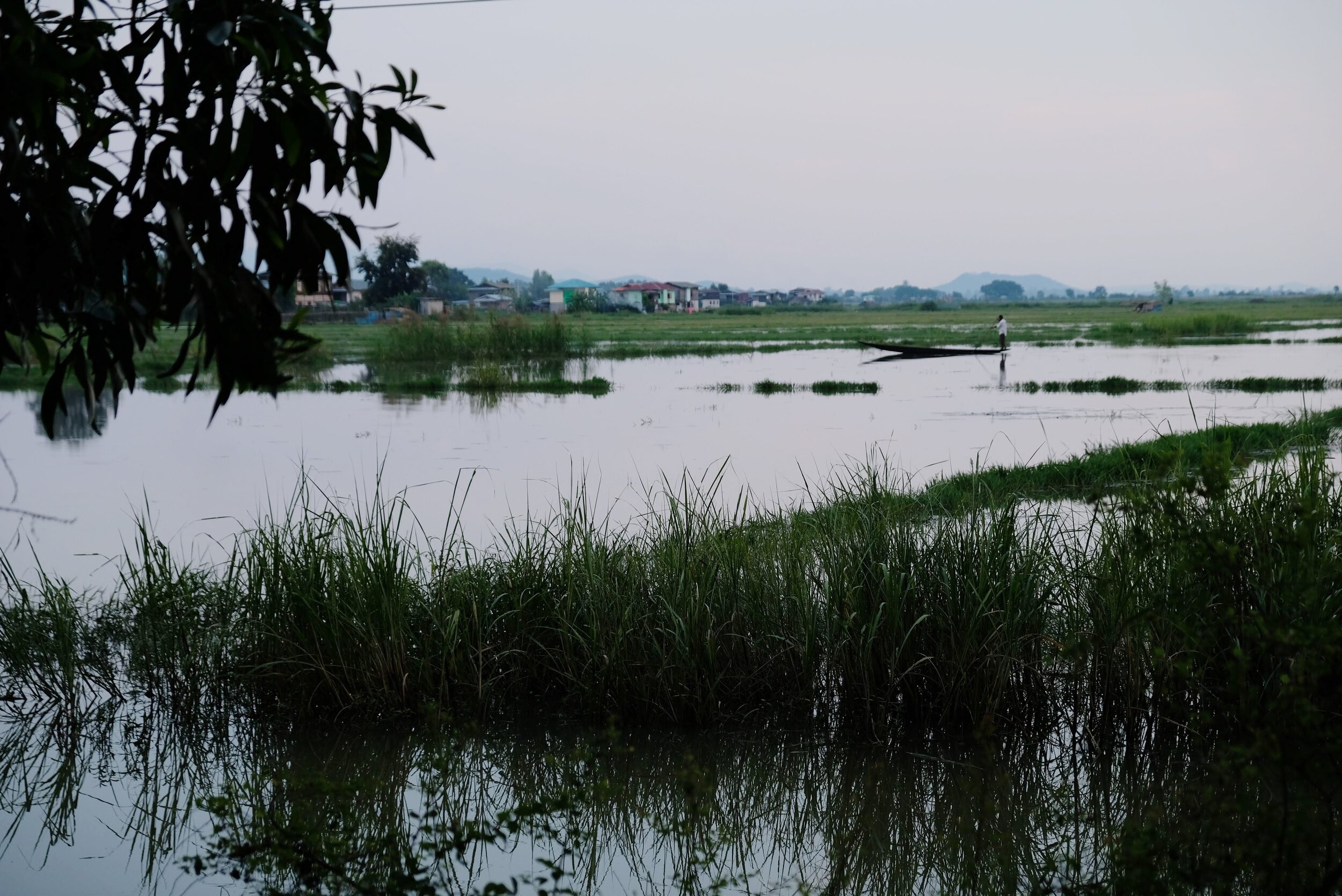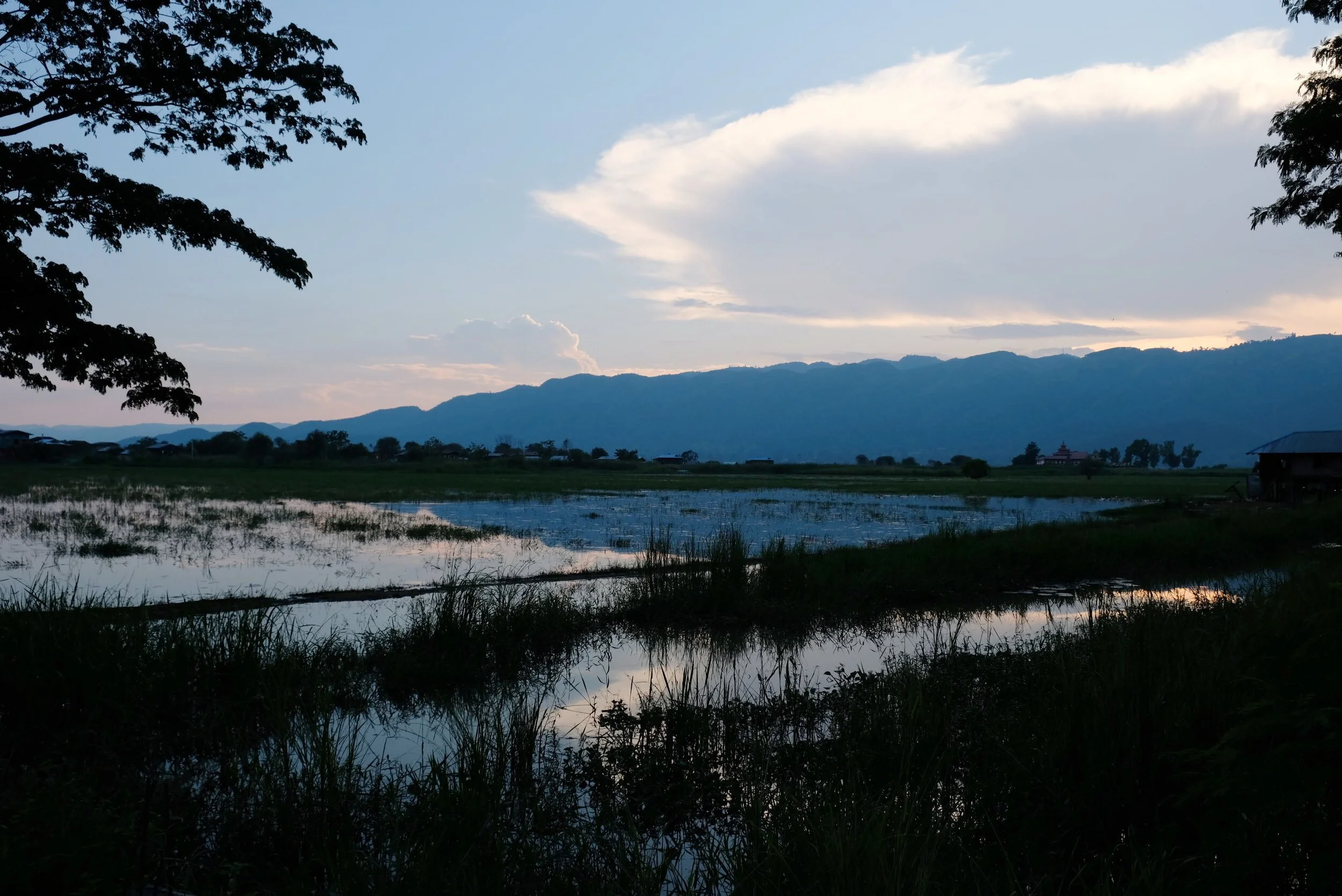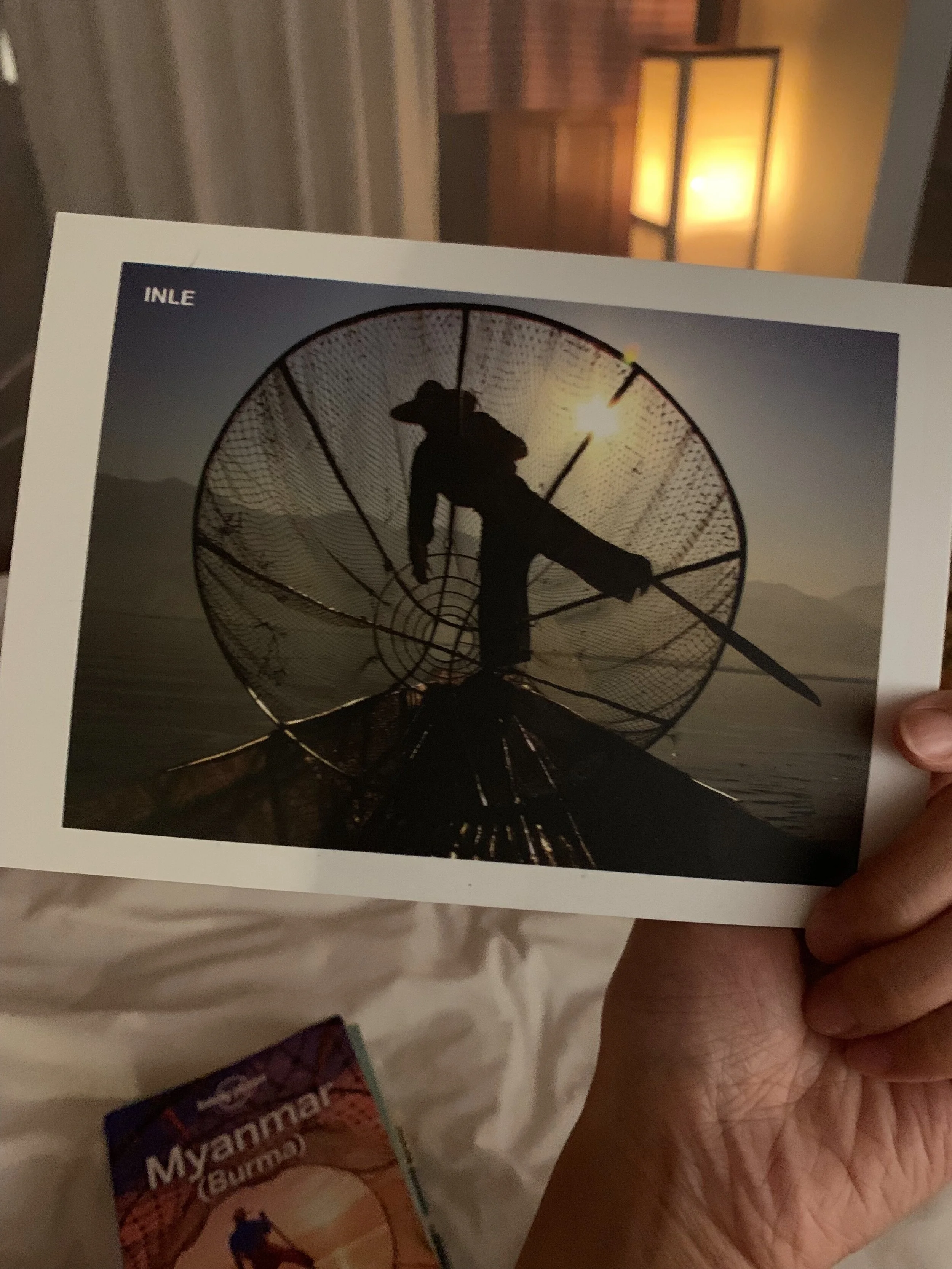Myanmar. September 2019
postcard from Mingun
The first day of arriving in Myanmar, I was alone. I landed at the airport after a full day of traveling, followed the dozen other travelers through the terminal, picked up my bag, entered the arrival hall at Yangon International Airport, and met my first friend in Myanmar. His first words to me were: “Taxi?”
It was a little nerve-wracking to be alone in an unfamiliar place, and I am glad he offered to help.
On our ride into the city to my hotel, he pointed out buildings and neighborhoods as we drove by, and gave me some tips on where to go on my short stay. As the scenery outside the car changed from country side to bustling city, I could tell Myanmar is rapidly changing. High rises are built left and right, the city looks nothing like what I have seen on the Lonely Planet guidebook. As we pulled into the hotel, Komg gave me his card and offered to take me around tomorrow before I head to the airport for Mandalay.
Yangon
After a much needed nap at the hotel, it was already passed dinner time and I knew I needed a meal. I looked up where the night market was, and asked the hotel staff how to get there. They got me a taxi and within 10 mins, I was at the Grilled Snack Stalls. After walking down the entire strip of 19th street, I settled at a grilled seafood stall/ open-air restaurant. I definitely ordered too much food for one, but hey, it’s the first night in the city and you have to celebrate with some street food and a Myanmar beer.
The next morning I decided to check out Rangoon Tea House for breakfast before meeting up with my friend to start the day tour of Yangon. The hipster, stylish teahouse is located right in main downtown area by the High Court, with the bottom floor as the main teahouse, and the top floor as the bar. The bottom floor was completely packed at 7AM on a weekday, and I was seated upstairs in the bar. Besides getting noodles for breakfast I also had to try the Burmese tea! It was delicious and well worth the sweaty walk from the hotel.
I know this looks like a bar but I am really at breakfast. The local green tea has a hint of dates with it and I actually thought it was a different kind of tea.
After breakfast I walked back to the hotel, passing by a golden temple right in the middle of a traffic circle. Sule Paya shines bright after the morning shower, observing the modern business life as the Monday morning commuters crowd over the nearby bus stop. I snapped a photo of Sule Paya as I walked across the footbridge back to my hotel.
Back at the hotel I was joined by my friend and we waited for Komg our driver for the day. He first took us on a downtown loop, stopping at Mahabandoola Garden. The sky was still cloudy, and the greenery was still damp from the morning rain. On the north side of the park is City Hall, and to the east is the British/ European influenced High Court, donning a red and white clock tower. In the center of the garden is the Independence Monument. It wasn’t hard to see glimpse of colonial Burma around the city, and that reminded me a little of home.
We made a few other stops in the downtown area, including the St. Mary Catholic Church, the largest cathedral in all of Myanmar, Kandawgyi Park where the palace once was, Chauk Htat Gyi the reclining Buddha temple, and Nga Htat Gyi Paya, the temple that houses a seated Buddha on a beautiful carved wooden backdrop.
After the smaller stops it was time for the main highlight of the day - Shwedagon Pagoda. Just in case you’re wondering, shwe in Burmese means gold, so very likely the name of a pagoda will have the words shwe in it. As you enter from one of the four entrances, the first thing that will capture your eye is the golden stupa rising at 325ft, surrounded by 4 smaller stupas and 64 smaller pagodas. The tip of the main stupa is made up of the umbrella, the vane that looks like a flag, and the diamond orb at the very top. I wasn’t able to see this with my bare eyes in the midday sun, but at the tip of the the diamond orb is a single 76-carat diamond.
As you walk clockwise around the stupa, there are 12 planetary posts that represent the days of the week and the ascending node of the moon. Locals gather around by pouring water over the the Buddha statue at the post that represents their day of birth. I followed suit and found my planetary post and did the same.
Pro tip for visiting the Shwedagon Pagoda - don’t come here in the middle of the day. It’s hot. Not only will you be sweating from the mid day heat, the marble floor is hot and you will likely be skipping and hopping like I was to avoid burning your foot. It does feel nice afterwards though - like someone had just given you a foot rub. If you’re a clean freak like me, wear sandals and bring wipes to clean off after visiting pagodas. We visited a few other pagodas in the area and went to lunch at Feel Myanmar Food. It was featured on Anthony Bourdain’s show and loved by locals and foreign-embassy staff alike. They have multiple locations and we happened to go to the one further away from the main part of town, on our way to the airport. After our very satisfying meal (and a moment to be indoors away from the heat), we headed to the airport for our late afternoon flight to Mandalay, a major population center of Upper Myanmar.
MANDALAY
After our 1.5 hour flight, we made it to Mandalay right before sunset. We arranged for the hotel to pick us up from the airport, and headed straight to Bagan King Hotel, a boutique hotel located in central Mandalay. We were debating if we would have enough time to stop by the famed U-Bein Bridge on our way to see the sunset, but our driver Tun said we won’t make it in time. Instead, Tun offered us an itinerary for the next day, and we decided to have him take us to Bagan tomorrow evening as well. For dinner we stopped by the nearby local favorite Mingalabar Myanmar Restaurant. It was described as the traditional Burmese “pick-and-pig-out” spot and it was exactly that. We tried a bunch of food on the menu and left very satisfied. Side note - Mingalaba is hello in Burmese, and Mingala-BAR therefore is a very popular name for restaurants and bars (it’s a cute name!)
Breakfast Time
One thing I missed the most in Asia is the complementary breakfast at hotels! At 7:30, I headed straight to the 6th floor for breakfast and it was THE BEST breakfast I’ve had on this entire trip. The hotel also has a stunning view of Mandalay as the city wakes up to the morning bustle.
Mingun
After breakfast Tun came to pick us up from the hotel and dropped us off at the tourist jetty heading to Mingun, a riverside village to the northwest side of Mandalay. The jetties all leave the port at exactly 9AM, arriving at Mingun at 10AM after the 1 hour boat ride. As we approach Mingun, the giant brown structure, known as the world’s largest pile of rocks, come into view. Along the way, waterfront houses lined the shore.
We disemarked the jetty, reminded that we have to be back at 12:30PM for our return journey.
We paid our entry fee for the area and walked along a dirt road, passing the Mingun Paya and the Mingun Bell, towards Hsinbyume Paya (Mya Thein Tan Pagoda). Built in 1816, the Hsinbyume Pagoda rises in seven wavy, whitewashed terraces representing the seven mountain ranges around Mt Meru - the mountain at the center of the Buddhist universe.
After suffering from mild dehydration yesterday from behind out under the sun for extended hours, I learned my lesson and purchased a 1L bottle after I finished my own. Walking back the same path we came, we headed to the Mingun Paya, the world’s largest unfinished stupa. From afar it indeed looks like a pile of bricks, and up close you can see deep cracks on the structure from the 1838 earthquake.
While walking around the stupa we were greeted by a herd of cows! We also got some souvenirs (you will be stopped and you will end up buying something because I got a longyi for 3 USD) from the street vendors and sellers.
The Giant Lions
Two Giant Chinthe Lions were designed to be the guardians of the Mingun Paya, to scare away evil forces. Now the only remains is the body as the lions’ heads have fallen from the 1838 earthquake, the same earthquake that left the deep cracks in Mingun Paya.
Mingun Waterfront.
Mandalay (Part II)
Back at Mandalay, Tun was already waiting for us at the pier, and we headed back to the hotel to pick up our bags. We stopped for lunch at Ginki restaurant near the hotel. We drove past the flower market, as well as the Mandalay Fortress Walls that surrounds the Mandalay Palace as we head to the other part of town. Tun took us to a few more pagodas at the foot of Mandalay Hill before making the ascent to the hilltop. We drove almost all the way up, winding through narrow one way paths. We caught glimpse of the city as we make our way up, wondering what the view would be like. We drove almost all the way up, the last leg being escalators to the top. We left our shoes at the car and went up barefoot on the escalators in this escalator tower that looks like an abandoned mall (it reminded me of the scene from The Day After Tomorrow). At the top of the escalator is the beautiful Su Taung Pyae Pagoda, gleaming from the sun. At one side of the building there were workers diligently cutting up glass pieces, the same ones you see surrounding the structure.
World’s Biggest Book
After Mandalay Hill, we headed to Kuthodaw Pagoda, where there are 729 text-inscribed marble slabs with its own stupa. The slabs are housed inside the grated entrance of each stupa, and together they make up the entire 15 books of the Tripotakathe. Along with another set of stabs in the nearby Sandamuni Paya, it’s cited as the world’s biggest book. The smaller white stupas surround the large gilt-and-gold stupa in the middle.
Bagan
Before sunset around 5PM we started our 3.5 hour drive to the temple town of Bagan. The sun was setting on our way and soon we were driving in the dark in a small town. I remember waking up when we entered the Bagan Archaeological Zone and paying our entrance fee. Despite being in the more rural part of town the way they tracked tourists is pretty advanced. Before I knew it the officers(?) snapped a photo of all of us (with flash!) with their handheld devices and printed a receipt with a QR code on it. I’m not really sure what that QR code does since it brought me to a dead link when I tried it with my phone…
We made it to The Hotel @ Tharabar Gate and settled into our spacious rooms. The first thing we did was shower after a full day outdoors! Since it was after dinner time we ordered room service instead of heading out to town and called it a night (the town isn’t a tourist destination like Siem Reap with nightlife anyway).
The next morning we got up at 4:30 to try to catch the sunrise on a very cloudy day. We biked in the dark towards Swesandaw Pagoda and Loka Oakshang Temple for sunrise but discovered some unfortunate news - that all the pagodas in Bagan are closed off and tourists are banned from climbing. Authorities cited damages from the rise of foot traffic and safety concerns, and there have been accidents since the recent earthquake in 2016. Despite not being about to climb the pagodas and get an aerial view of the city, we made the most of it and explored all the pagodas nearby. Each stop we parked our bikes right outside, took our shoes off and stepped into one of the 3,500 stupas in the ancient city.
Ancient beauty
Bagan was just named a Unesco World Heritage Site in July of 2019.
We biked further down the dirt path (some of these dirt paths are all sand and it’s completely un-bikeable so we had to “walk” our bikes) and came across another huge pagoda, Dhammayangyi Pahto. There was a manmade mound nearby that allowed us to get a little view. We went inside the pagoda, and read up on the rich history of this place.
21.161922°N, 94.872866°E
One of the spookiest pagodas in Bagan, Dhammayangyi Pahto was created by King Narathu to atone for his sins. Inside the dark hallways we heard bats circling the high ceilings, and the inner hallways remain dark.
After Dhammayangyi Pahto, we headed to Ananda Pahto, one of the best preserved and most revered of all Bagan temples. With a gold hti at the top and an white glazed exterior, it stands out from all the other pagodas in Old Bagan. It’s got huge carved teak doors on all four sides leading to a golden Buddha on each side. This pagoda is definitely one of the prettiest and I spent a good 20 minutes admiring the details on the glazed tiles.
We made our way back to the hotel on our bikes for breakfast, did a little bit more research on the next cluster of pagodas and headed out again on our bikes. We biked across the city wall to Thatbyinnyu Pahto, Bagan’s highest temple. We then biked to the nearby Mimalaung Kyaung, which has a set of stairs leading up to the square monastery platform. From there we could get a view of Thatbyinnyu Pahto.
Before lunch we also stopped by Gawdawpalin Pahto, another one of the larger Bagan temples and Bupaya on the bank of the Ayeyarwady River. Though not the original gold stupa from 3rd century, the reconstruction built after the 1975 earthquake is still a sight.
Our lunch spot was Mi San, a local eatery that is on an unnamed road leading to Bupaya. You know you’re about to get really good food if it looks like you’re walking into someone’s home. It was the best coconut rice I’ve had this entire trip and the best of all our total bill for 3 people came out to $7.8 USD.
Before heading back to the hotel we stopped by Mahabodhi Paya, which, unlike other Bagan temples, has Buddha carvings on all sides of the building all the way up to the pyramidal spire.
By early afternoon we were all suffering from a little temple fatigue. While my friends went back to the hotel for a short break, I took an excursion to the Mani-Sithu Market in the nearby Nyuang U. A traditional market in the bustling river town, Mani-Sithu was a colorful display of the local fruits, vegetables, flowers and crafts. Surprisingly when I visited in the afternoon there was not a single tourist in sight.
One of the most well known (and most instagrammable) activity in the Bagan Archaeological Zone is probably the hot air ballooning that provides an aerial view of the ancient city over sunrise/ sunset. Unfortunately when we visited it wasn’t hot air balloon season yet (this is one of the down side of traveling off-season), and we opted for a view of the city from Nan Myint Tower, a 12-story, round building located in Nyaung U. As Lonely Planet put it, the building is a “complete eyesore” as it stands out from the thousand year old pagodas in the archaeological zone. Nonetheless we were able to get a view of the sunset over the beautiful city before the clouds gathered. We could even see Mt Popa in the distance.
As we leave the tower for dinner on our tuk tuk, of course the monsoon rain came down on us as we headed to Black Bamboo for dinner. My rain jacket provided little protection against the heavy rain and we arrived at our restaurant completely soaked. We ordered our food and warmed ourselves up with tea but the rain came down so hard that it took out the power for the entire block! We ended up having the first part of the meal in the dark with a portable lamp until the power came back up.
The next morning we made another attempt for sunrise but skies were cloudy again in the morning. We decided to check out some of the pagodas we passed by on our way to Nyuang U yesterday. On our bike ride we passed by a group of tourists on carriages coming off a dirt road and decided to find out where they were coming from. It turns out they were visiting Yin-ma-na-hpaya and a group of pagodas in the area. There was a shed(?) and a man-made mount that gives you a view of the river and the nearby pagodas.
After the fun excursion we biked back to the hotel for breakfast and it was time to check out and head to the Nyuang U airport for our flight to Heho airport for Inle Lake!
Inle Lake
Arriving on our small airplane in the small Heho airport, we were picked up by our driver and headed for our hotel in Inle Lake. We drove through a mountain and through town into Inle Lake. The hotel is a luxury resort right on the lake with a private deck access to the lake, but it didn’t occur to us just how empty the resort was when until lunch time when we were the only group eating, and no one else was around…(more on this later)
We boarded our motor boat from the dock of the hotel and headed towards Inthein. The skies started getting cloudy on the way to the lakeside village, and soon enough it started raining as we made our way through the narrow, foilage-cloaked canal on the south western side of the lake. With our rain gear we entered Shwe Inn Thein Paya, going through a set of covered stairway that I imagined are usually lined with vendors and stalls and up to the hill. When we visited on the rainy day off season we saw maybe a total of 3 stalls open?
The paya itself is comprised of 1054 stupas, most of them from the 17th and 18th century. There are some with plaques from donations and some with no Buddhas inside. We walked around barefoot in the rain and managed to get a few photos before heading back.
On our way back, our boat driver took us to Ywama village, one of the first village in the area to be developed for tourism. We stopped by a silversmith showroom and saw how silver cups and jewelry were made. I ended up getting a fishing net charm (even though I didn’t see it being used on the lake). The rain finally stopped while we were at the showroom, and we got a chance to see the sunset on the lake! The view over floating gardens where tomatoes are grown over water were magical.
It became really apparent that the resort we were staying at was not at its maximum occupancy at dinnertime as there were more staff serving dinner than guests. Part of the resort wasn’t even lit up as there were no guests staying in that part of the resort. Wifi and cell signal weren’t working great so I had a nice digital detox.
The next morning we have another half day boat trip scheduled before my friends and I split up and I finish the rest of my Myanmar trip on my own. It’s another cloudy morning and it started raining again when we were back in Ywama village for the long neck ladies and umbrella making. We then headed to In Phaw Khone village for lotus silk and cotton making/ hand weaving. The lotus plants grown on Inle Lake have strong fibers that look like spiderwebs and they are made into strings for weaving. It takes 20 days to make a scarf from lotus fiber and we saw the hand weaving in action.
Our last stop on the boat tour was boat making and cheroot tobacco in Nan Pan. The boats all around Inle Lake are made with teak wood from the southern states of Myanmar, and the lacquer that is used as the coat is from the Shan State. To make the boat waterproof, they mix lacquer, cotton and teak wood powder. The teak wood is so heavy that it takes 7 men to move it up to the platform for cutting. It takes a month to coat a boat and costs 280,000 Kyat, about $180 USD.
As we were heading back to the hotel the sky started to clear and I finally got some decent shots of Inle Lake.
We returned to the hotel and I sent my friends off to the airport, and I am on my own for the rest of the journey! I borrowed a bike from the hotel, and headed east to the nearby village of Maing Thauk 5km away. The sun was out and I was able to bike in great weather. Half of the village is on dry land, while the other half sits on stilts over the water, connected by a 450 yard wooden bridge (I’ve been told this bridge resembles U-Bein bridge in Mandalay). There are floating farmlands to both sides of the bridge, and as you walk down the bridge there will be lots of boat drivers offering to take you out to Inle Lake. I even saw a cat jump up and down from the boats parked by the bridge!
I biked to Star Light, a restaurant by the Maing Thauk market, for lunch. I sat outside by the field, ordered a fried fish with tomato sauce with rice, and a lime juice. It was possibly the best meal I had in Myanmar.
Lunch with a view for $3.3 USD.
After lunch I felt ambitious and decided to walk the bike up the hill to the Maing Thauk Forrest Monastry that was 3km away. It was actually quite the walk with the sun and a bike, and I am pretty sure the ladies who were mending the trees and bushes on the side of the road were joking about how I am pushing a bike up the hill? The walk up took me a good 40 to 45 mins, all the while I was thinking about how liberating it would feel to come down the same hill on the bike. I parked the bike by the monastery, and went up the stairs. It must have been recess time when I visited as little monks were out from the classrooms and hanging around the hallways. I made a turn to the left on the top of the stairs and walked passed a golden rock that resembles the actual Golden Rock in Mon State. I went down a tree-lined path, finally making it to the gold pagoda at the top of the hill. The sun is fully out and you can see a clear view of the entire lake. It was very calming and peaceful at the monastery, and on my way back to the bike, a female monk picking white flowers offered some to me!
I headed back to my bike with the flowers in a ziplock bag, and biked down the hill with the breaks on the whole time. It felt great and I definitely enjoyed the nice breeze because I was dripping in sweat from the hike up!
After returning to the hotel I patiently waited for the sunset from the dock of the hotel, and was joined by other hotel guests (thank God I wasn’t alone at the hotel anymore because it really started to sound like the beginning of a scary story).
Nyuang Shwe
I’m on my own schedule today! After breakfast at the resort I transferred to a different hotel in Nyuang Shwe, a town on the north end of the lake. My hotel for the remaining of my stay is called La Maison Birmane, a lovely boutique hotel that offers wooden bungalows set around a garden. Upon setting foot in the hotel I felt really welcomed and I couldn’t wait to check out my own bungalow. The staff allowed me to check in early and offered suggestions of where I should go given my stay in the area the last 2 days. The keychain to my room keys has hand-sewn buttons to represent the room number, and my room was lovely and even has a little terrace!
I was able to plan out my day a little bit more and decided to stick with my original plan of biking to Khaung Daing, a countryside Intha village on the northwest corner of the lake. Before heading over I stopped at Thukha Cafe, Nyuang Shwe’s only Muslim teahouse, for some tea and complimentary coconut pastry (I even saved some for the road!)
I needed to find a place to rent a bike for the trip, and stumbled upon a bike tour place that rents out mountain bikes. I got a bike for half a day, and off I go on the 1.5 hour one-way bike trip! The ride is first dirt road through rice paddies, and then after a left turn at the end of the road it’s another long, tree-lined road to town. At times the roads do get bumpy, and there are even some small hills! I managed to figure out how to work the gear change on the mountain bike about quarter of the way to save my quads HA.
A flurry friend eyeing my snack for the road.
Khaung Daing
It took me about 40 mins to get to Khaung Daing’s hot springs, but I wanted to keep going to visit the actual town. Since Google map didn’t exactly have a location of the actual town I passed by a few markets/ pagodas searching for the actual town. I kept going further south, looking for a place I found on Google called Tofu Palace that offers food tour. Immediately upon sitting down, I was served some delicious fried tofu! 2 ladies from Israel joined me on the donation based food tour, and our tour guide Soe showed us the different foods made in town. We started with tofu making from chickpeas local to Myanmar instead of the typical soy. We also sweet and fried snacks in the making.
As we were walking to different parts of town, Soe explained that his wife is a secondary school teacher, and that each village usually has a primary school, but only a cluster of villages would have a secondary school. Students would stay in “dorms” so it’s easier for them to get to school. Since I mentioned I grew up in Hong Kong, he said there are 2 HKU students in the village teaching English on an exchange program! Soe also showed me how older houses in Myanmar are made with bamboo and teak wood roofs, and newer houses are made with concrete and have metal sheet roofs.
We made a few other stops - one for the rice alcohol, and another for roasting of seeds and nuts, and finally soy bean cracker making. Even though there are sunflowers grown in the area, the sunflower seeds aren’t from the area and they processed them locally by adding ginger, garlic, sugar and salt for roasting. Peanuts, chickpeas and white beans are all grown in the area, and the men and women roast and prepare them for sale to other regions in the country. Everyone I met in the village was super nice and excited to show others the production of their village. As we head back, Soe mentioned they are looking to draw more people to their village and show others what it’s like to be living in town. The cost of the tour goes as a donation to the town, to help add trashcans and start the recycling program, as well as funds for the school and monastery. Before leaving Soe made sure I try the spicy tofu salad before biking back to Nyuang Shwe.
On the bike ride back to Nyuang Shwe I passed by a group of students on the top of a truck all singing and saying hi to me ask I biked passed them! A herd of cows also made an appearance before a beautiful sunflower field.
Sunset over the rice paddies aren’t half bad either.
I made it back to town by 5:30 before sunset, and rested a little at the hotel before heading out to the night market for dinner. It’s a short 5 min walk from the hotel, and despite being a small market, there were plenty of options for food! I ordered a fried noodle with a Myanmar beer 🍺 (I thought it was a small bottle but it wasn’t!). There were also souvenir stalls at the market and I got myself a bracelet and a postcard to mail to myself.
The next morning I have to leave the hotel at 8AM to catch the flight back to Yangon and onwards to Hong Kong, and since it was Sunday and the post office isn’t open I asked the staff at breakfast if they could mail the postcard for me. It’s been an amazing journey and this trip really reminded me how nice it is go on a solo (or semi-solo in this case) and just explore. It was great to wander, knowing there is a place you go home to. Thank you Myanmar! ❤️




